LG Electronics USA L170 17" TFT LCD Monitor User Manual Microsoft PowerPoint F User s Manual
LG Electronics USA 17" TFT LCD Monitor Microsoft PowerPoint F User s Manual
users manual

APPENDIX F :
FCC ID : BEJL170
USER’S MANUAL
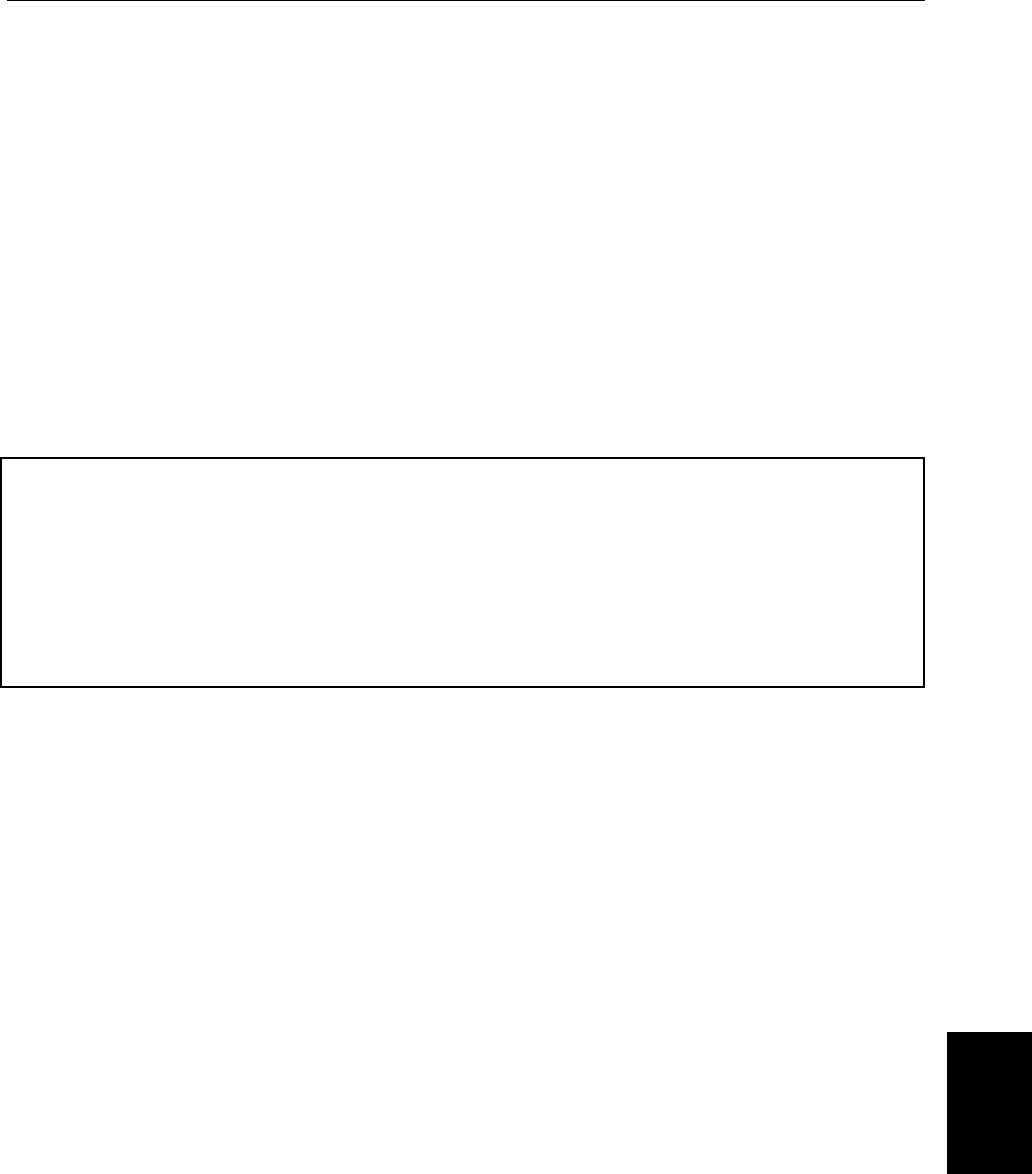
1
APPENDIX
Compliances
This equipment has been tested and found to comply with the limits for a Class B digital device, pursuant to
Part 15 of the FCC Rules. These limits are designed to provide reasonable protection against harmful
interference in a residential installation. This equipment generates, uses, and can radiate radio frequency
energy and, if not installed and used in accordance with the instructions, may cause harmful interference to
radio communications. However, there is no guarantee that interference will not occur in a particular
installation. If this equipment does cause harmful interference to radio or television reception, which can be
determined by turning the equipment off and on, the user is encouraged to try to correct the interference by
one or more of the following measures:
•Reorient or relocate the receiving antenna.
•Increase the separation between the equipment and receiver.
•Connect the equipment into an outlet on a circuit different from that to which the receiver is connected.
•Consult an IBM authorized dealer or service representative for help.
Properly shielded and grounded cables and connectors must be used in order to meet FCC emission limits.
Proper cables and connectors are available from IBM authorized dealers. IBM is not responsible for any radio
or television interference caused by using other than recommended cables and connectors or by
unauthorized changes or modifications to this equipment. Unauthorized changes or modifications could void
the user’s authority to operate the equipment.
Declaration of Conformity Trade name
Trade name: IBM Corporation
Model Nos.: 6734-AB9, 6734-AG9 and 6734-AW9
Responsible Party: LG Electronics USA Inc.
Address: 6133 North River Road Suite 1100 (Riverview Plaza) Rosemont, Illinois, 60018
Telephone No.: 847-692-4630 ext 329
This Device complies with Part 15 of the FCC Rules. Operation is subject to the following two conditions:
(1) This device may not cause harmful interference, and (2) this device must accept any interference received,
including interference that may cause undesired operation.
Power Cords
For your safety, IBM provides a power cord with a grounded attachment plug to use with this IBM product. To
avoid electrical shock, always use the power cord and plug with a properly grounded power outlet.
IBM power cords used in the United States and Canada are listed by the Underwriter’s Laboratories (UL) and
certified by the Canadian Standards Association (CSA).
For units intended to be operated at 115 volts: Use a UL-listed and CSA-certified cord set consisting of a
minimum 18 AWG, Type SVT or SJT, three-conductor cord, a maximum of 15 feet in length and a parallel
blade, grounding-type attachment plug rated 15 amperes, 125 volts.
For units intended to be operated at 230 volts (U.S. use): Use a UL-listed and CSA-certified cord set
consisting of a minimum 18 AWG, type SVT or SJT, three-conductor cord, a maximum of 15 feet in length
and a tandem blade, grounding-type attachment plug rated 15 amperes, 250 volts.
For units intended to be operated at 230 volts (outside the U.S.): Use a cord set with a grounding-type
attachment plug. The cord set should have the appropriate safety approvals for the country in which the
equipment will be installed.
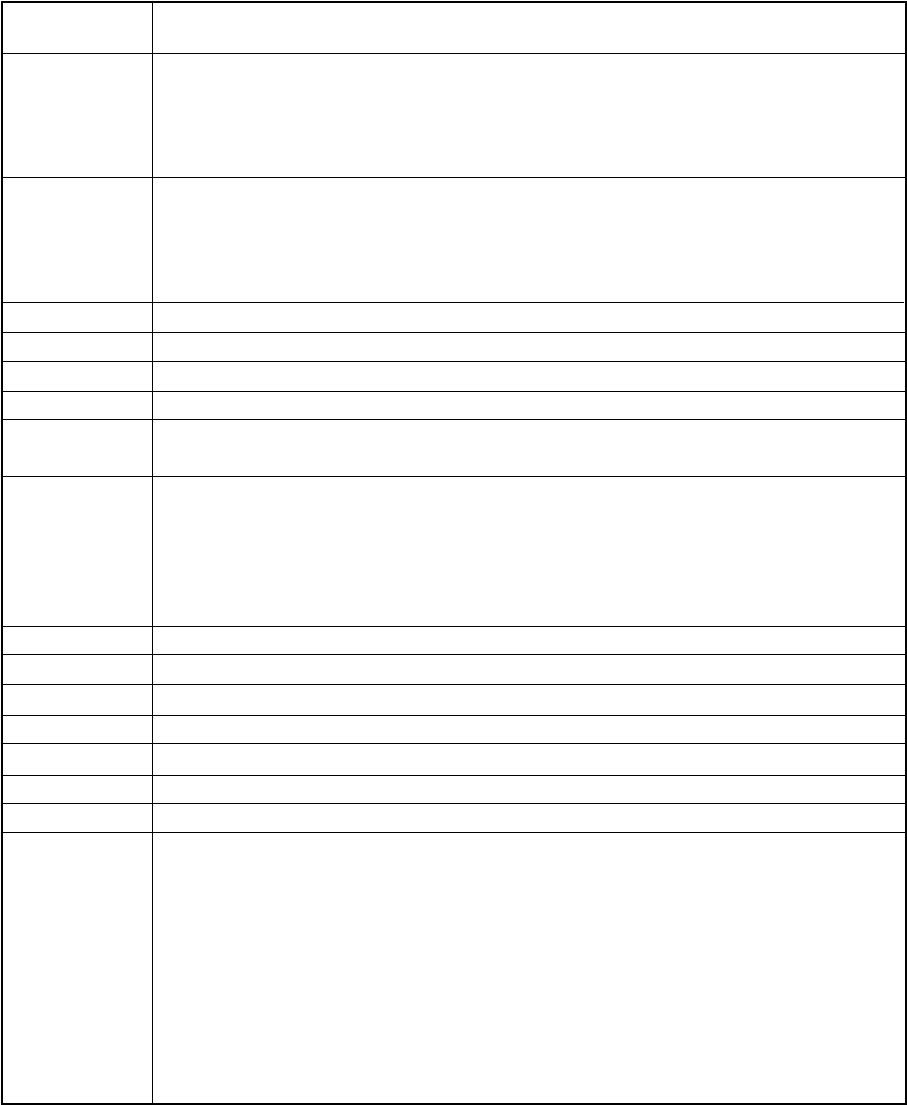
2
IBM power cords for a specific country or region are usually available only in that country or region.
Used in these countries or regions
IBM power cord
part number
74P4360
74P4362
74P4366
74P4368
74P4370
74P4372
74P4374
74P4376
74P4378
74P4380
74P4382
74P4384
74P4386
74P4388
74P4390
74P4364
Antigua and Barbuda, Aruba, Bahamas, Barbados, Belize, Bermuda, Bolivia, Calicos Island,
Canada, Cayman Islands, Costa Rica, Columbia, Cuba, Dominican Republic, Ecuador, El
Salvador, Guam, Guatemala, Haiti, Honduras, Jamaica, Mexico, Micronesia (Federal States of),
Netherlands Antilles, Nicaragua, Panama, Peru, Philippines, Saudi Arabia, Thailand, Taiwan,
United States, Venezuela
Antigua and Barbuda, Aruba, Bahamas, Barbados, Belize, Bermuda, Bolivia, Brazil, Caicos
Islands, Canada, Cayman Islands, Costa Rica, Columbia, Cuba, Dominican Republic, Ecuador,
El Salvador, Guam, Guatemala, Haiti, Honduras, Jamaica, Japan, Mexico, Micronesia (Federal
States of), Netherlands Antilles, Nicaragua, Panama, Peru, Philippines, Taiwan, United States,
Venezuela
Denmark
Liechtenstein, Switzerland
Israel
Chile, Italy, Libyan Arab Jamahiriya
Bangladesh, Lesotho, Maceo, Maldives, Namibia, Nepal, Pakistan, Samoa, South Africa, Sri
Lanka, Swaziland, Uganda
Abu Dhabi, Bahrain, Botswana, Brunei Darussalam, Channel Islands, Cyprus, Dominica,
Gambia, Ghana, Grenada, Guyana, China (Hong Kong S.A.R), Iraq, Ireland, Jordan, Kenya,
Kuwait, Liberia, Malawi, Malaysia, Malta, Myanmar (Burma), Nigeria, Oman, Qatar, Saint Kitts &
Nevis, Saint Lucia, Saint Vincent and the Grenadines, Seychelles, Sierra Leone, Singapore,
Sudan, Tanzania (United Republic of), Trinidad & Tobago, United Arab Emirates (Dubai), United
Kingdom, Yemen, Zambia, Zimbabwe
Australia, Fiji, Kiribati, Nauru, New Zealand, Papua New Guinea
Korea (Democratic Peoples Republic of), Korea (Republic of)
Japan
India
China (PRC)
Brazil
Argentina, Paraguay, Uruguay
Afghanistan, Albania, Algeria, Andorra, Angola, Armenia, Austria, Azerbaijan, Belarus, Belgium,
Benin, Bosnia and Herzegovina, Bulgaria, Burkina Faso, Burundi, Cambodia, Cameroon, Cape
Verde, Central African Republic, Chad, Comoros, Congo (Democratic Republic of), Congo
(Republic of), Cote D'lvoire (Ivory Coast), Croatia (Republic of), Czech Rep, Dahomey, Djibouti,
Egypt, Equatorial Guinea, Eritrea, Estonia, Ethiopia, Finland, France, French Guyana, French
Polynesia, Gabon, Georgia, Germany, Greece, Guadeloupe, Guinea, Guinea Bissau, Hungary,
Iceland, Indonesia, Iran, Kazakhstan, Kyrgyzstan, Laos (Peoples Democratic Republic of),
Latvia, Lebanon, Lithuania, Luxembourg, Macedonia (former Yugoslav Republic of),
Madagascar, Mali, Martinique, Mauritania, Mauritius, Mayotte, Moldova (Republic of), Monaco,
Mongolia, Morocco, Mozambique, Netherlands, New Caledonia, Niger, Norway, Poland,
Portugal, Reunion, Romania, Russian Federation Rwanda, Sao Tome and Principe,
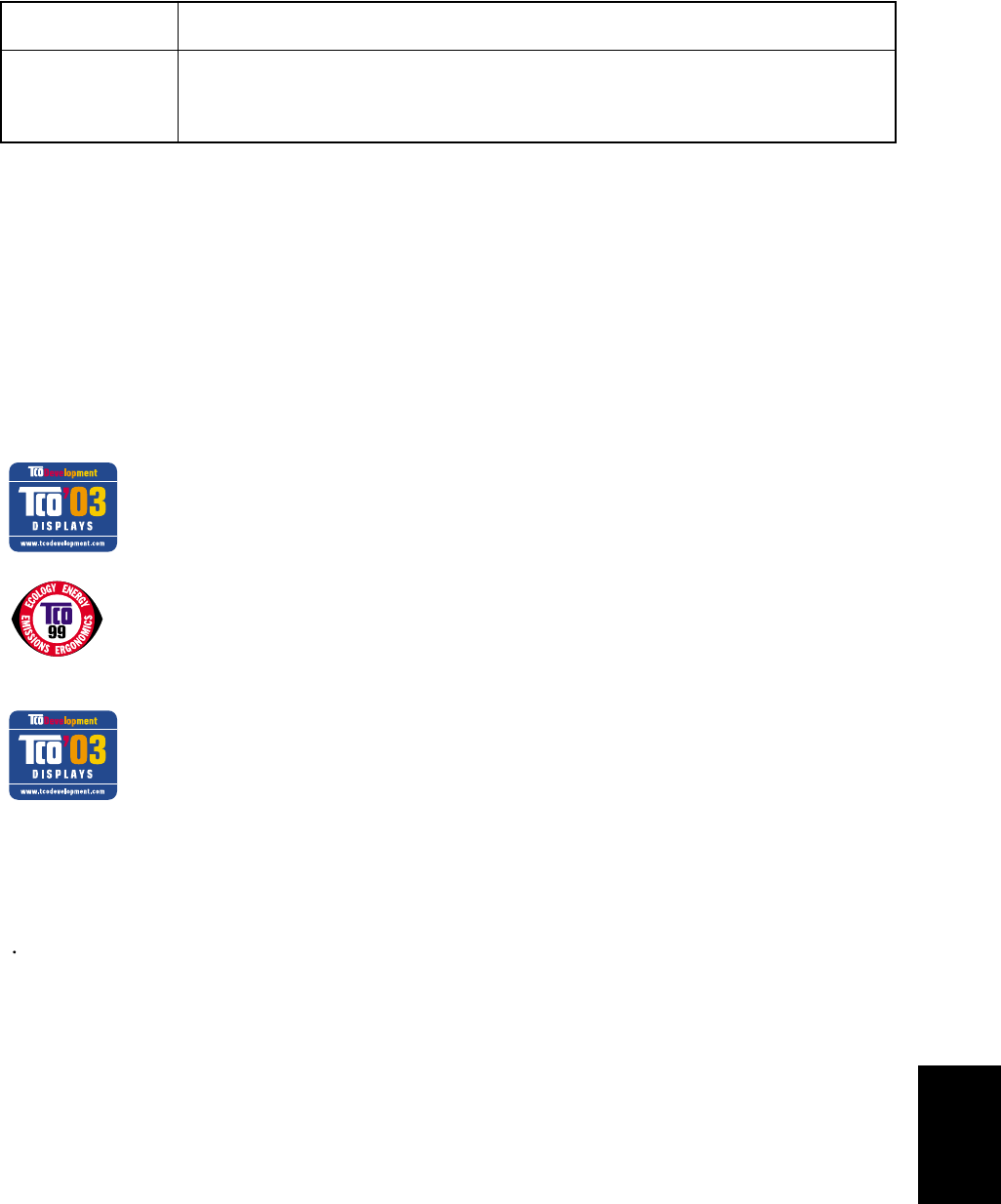
3
APPENDIX
Industry Canada Class B emission compliance statement
This Class B digital apparatus complies with Canadian ICES-003.
Cet appareil numérique de la classe B respecte toutes les exigences du Réglement sur le matériel
brouilleur du Canada.
Avis de conformité à la réglementation d'Industrie Canada
Cet appareil numérique de classe B est conforme à la norme NMB-003 du Canada.
Used in these countries or regions
IBM power cord
part number
74P4364 Saudi Arabia, Senegal, Serbia, Slovakia, Slovenia (Republic of), Somalia, Spai, Syrian Arab
Republic, Tajikistan, Tahiti, Togo, Tunisia, Turkey, Turkmenistan, Ukraine, Upper Volta,
Uzbekistan, Vanuatu, Vietnam, Wallis and Futuna, Yugoslavia (Federal Republic of), Zaire
Models 6734-AB9 and 6734-AW9 comply with TCO ’99 guidelines.
Model 6734-AG9 comply with TCO ’03 guidelines.
TCO Compliances Section
Congratulations!
The display you have just purchased carries the TCO’03 Displays label. This means
that your display is designed, manufactured and tested according to some of the
strictest quality and environmental requirements in the world. This makes for a high
performance product, designed with the user in focus that also minimizes the impact on
our natural environment.
Some of the features of the TCO’03 Display requirements:
Ergonomics
Good visual ergonomics and image quality in order to improve the working environment for the user
and to reduce sight and strain problems. Important parameters are luminance, contrast, resolution,
reflectance, colour rendition and image stability.

4
Why do we have environmentally labeled computers?
In many countries, environmental labeling has become an established method for encouraging the
adaptation of goods and services to the environment. With the growing manufacture and usage of
electronic equipment throughout the world, there is a recognized concern for the materials and
substances used by electronic products with regards to their eventual recycling and disposal. By proper
selection of these materials and substances, the impact on the environment can be minimized.
There are also other characteristics of a computer, such as energy consumption levels, that are
important from the viewpoints of both the work (internal) and natural (external) environments. Electronic
equipment in offices is often left running continuously, resulting in unnecessary consumption of large
amounts of energy and additional power generation. From the standpoint of carbon emissions alone,
it is vital to save energy.
What does labeling involve?
This product meets the requirements for the TCO’99 scheme which provides for international and
environmental labeling of personal computers. The labeling scheme was developed as a joint effort by
the TCO (The Swedish Confederation of Professional Employees), Svenska Naturskyddsforeningen
(The Swedish Society for Nature Conservation) and Statens Energimyndighet (The Swedish National
Energy Administration)Approval requirements cover a wide range of issues: environment, ergonomics,
emission of electric and magnetic fields, energy consumption and electrical safety.
Energy
Energy-saving mode after a certain time – beneficial both for the user and the environment
Electrical safety
Emissions
Electromagnetic fields
Noise emissions
Ecology
The product must be prepared for recycling and the manufacturer must have a certified
environmental management system such as EMAS or ISO 14 000
Restrictions on
chlorinated and brominated flame retardants and polymers
heavy metals such as cadmium, mercury and lead.
The requirements included in this label have been developed by TCO Development in co-operation
with scientists, experts, users as well as manufacturers all over the world. Since the end of the 1980s
TCO has been involved in influencing the development of IT equipment in a more user-friendly
direction. Our labeling system started with displays in 1992 and is now requested by users and IT-
manufacturers all over the world.
For more information, please visit
www.tcodevelopment.com
Congratulations!
You have just purchased a TCO’99 approved and labeled product! Your choice has
provided you with a product developed for professional use. Your purchase has also
contributed to reducing the burden on the environment and also to the further
development of environmentally adapted electronics products.

5
APPENDIX
Environmental criteria impose restrictions on the presence and use of heavy metals, brominated and
chlorinated flame retardants, CFCs (freons) and chlorinated solvents, and other materials. The product
must be prepared for recycling and the manufacturer is obliged to have an environmental policy which
must be adhered to in each country where the company implements its operational policy.
Energy requirements include a demand that the computer and/or display, after a certain period of
inactivity, shall reduce its power consumption to a lower level in one or more stages. The length of time
to reactivate the computer shall be reasonable for the user.
Labeled products must meet strict environmental demands, for example, in respect of the reduction of
electric and magnetic fields as well as physical and visual ergonomics.
Below you will find a brief summary of the environmental requirements met by this product.
The complete environmental criteria document may be ordered from:
TCO Development
SE-114 94 STOCKHOLM, Sweden
Fax: +46 8 782 92 07
E-mail (Internet): development@tco.se
Current information regarding TCO’99 approved and labeled products may also be obtained via the
Internet, using the address: http://www.tcodevelopment.com/
Environmental requirements
Flame retardants
Flame retardants are present in printed circuit boards, cables, wires, casings and housings. Their
purpose is to prevent, or at least to delay the spread of fire. Up to 30% of the plastic in a computer
casing can consist of flame retardant substances. Most flame retardants contain bromine or chlorine,
and those flame retardants are chemically related to PCBs. Both the flame retardants containing
bromine or chlorine and the PCBs are suspected of giving rise to health effects, including reproductive
damage in fish-eating birds and mammals, due to the bio-accumulative* processes when not disposed
of in accordance with strict standards for disposal.
The relevant TCO’99 demand requires that plastic components weighing more than 25 grams must not
contain flame retardants with organically bound bromine or chlorine. Flame retardants are allowed in
the printed circuit boards since no substitutes are available.
Cadmium**
Cadmium is present in rechargeable batteries and in the colour-generating layers of certain computer
displays.
The relevant TCO’99 requirement states that batteries, the colour-generating layers of display screens
and the electrical or electronics components must not contain any cadmium.
_______________________________________________________________________________
*Bio-accumulative is defined as substances which accumulate within living organisms.
**Lead, Cadmium and Mercury are heavy metals which are bio-accumulative.

6
Mercury**
Mercury is sometimes found in batteries, relays and switches. The relevant TCO’99 requirement states
that batteries may not contain any mercury. It also demands that mercury is not present in any of the
electrical or electronics components associated with the labeled unit. There is however one exception.
Mercury is, for the time being, permitted in the back light system of flat panel monitors as there today is
no commercially available alternative. TCO aims on removing this exception when a mercury free
alternative is available.
CFCs (freons)
The relevant TCO’99 requirement states that neither CFCs nor HCFCs may be used during the
manufacture and assembly of the product or in its packaging. CFCs (freons) are sometimes used for
washing printed circuit boards. CFCs break down ozone and thereby damage the ozone layer in the
stratosphere, causing increased reception on earth of ultraviolet light. This restriction assures that
further damage to the ozone layer form this type of equipment will be eliminated.
Lead**
Lead can be found in picture tubes, display screens, solders and capacitors. The relevant TCO’99
requirement permits the inclusion of lead since no replacement has yet been developed.
_______________________________________________________________________________
**Lead, Cadmium and Mercury are heavy metals which are bio-accumulative.
ENERGY STAR®Compliances Section
Congratulations!
You have just purchased an ENERGY STAR®qualified product.
What is an ENERGY STAR®qualified product?
The ENERGY STAR®program is a voluntary partnership between the U.S. Environmental Protection
Agency / Dept. of Energy and Partners to reduce pollution and save energy. An ENERGY STAR®qualified
product meets or exceeds the energy criteria defined in an MOU (Memorandum of Understanding) for
that product category. As an ENERGY STAR®Partner, IBM offers ENERGY STAR®qualified computers,
monitors and printers that meet the growing performance and networking needs of customers while
reducing energy use, saving you money and improving the environment.
IBM is a recognized leader in providing energy efficient office products. In 1998 and 1999, IBM
received the ENERGY STAR®Computer Partner of the Year award in the office equipment category and
in 2001, IBM received the first ENERGY STAR®Excellence in Corporate Commitment award. ENERGY
STAR®products save you more -- look for the ENERGY STAR®label and program information on IBM
products, product literature, Web sites, packaging and promotional material.
As an ENERGY STAR®Partner, IBM Corporation
has determined that this product meets the
ENERGY STAR®guidelines for energy efficiency

7
APPENDIX
ENERGY STAR®
Current criteria and information regarding the ENERGY STAR®program can be found at
http://www.energystar.gov
ENERGY STAR®and the ENERGY STAR®logo are registered US marks.
MPRII
This product complies with Swedish National Council for Metrology (MPR) standards issued in
December 1999 (MPRII) for very low frequency (VLF) and Extremely low frequency (ELF) emissions.
Electronic emission notices
Hinweise
Gemäß der Amtsblätter des BMPT Nm. 61Ú1991 und 6Ú1992 wird der Betreiber darauf aufmerksam
gemächt, daß die von ihm mit diesem Gerät zusammengestellte Anlage auch den technischen
Bestimmungen dieser Amtsblätter genügen muß.
Aus ergonomischen Gründen wird empfohlen, die Grundfarbe Blau nicht auf dunklem Untergrund zu
verwenden (schlechte Erkennbarkeit, Augenbelastung bei zu geringem Zeichenkontrast).
Aus ergonomischen Gründen sollten nur Darstellungen auf dunklem Hintergrund bei
Vertikalfrequenzen ab 60 Hz (ohne Zeilensprung) benutzt werden.
Die Konvergenz des Bildes kann sich auf Grund des Magnetfeldes am Ort der Aufstellung aus der
Korrekten Grundeinstellung verändern. Zur Korrektur empfiehlt es sich deshalb, die Regler an der
Frontseite für H STAT und V STAT so einzustellen, daß die getrennt sichtbaren Farblinien für Rot.
Grün und Blau bei z.B. der Darstellung eines Buchstabens zur Deckung (Konvergenz) gelangen. Siehe
hierzu auch die Erklärungen zu H STAT und V STAT.
European Union (EU) Statement
This product is in conformity with the protection requirements of the EU Council Directive 89/366/ECC
on the approximation of the laws of the Member States relating to electromagnetic compatibility
IBM can not accept responsibility for any failure to satisfy the protection requirements resulting from a
non-recommended modification of the product, including the fitting of non-IBM option cards.
This product has been tested and found to comply with the limits for Class B Information Technology
Equipment according to CISPR 22 Ú European Standard EN55024:1998. The limits for Class B
equipment were derived for typical residential environments to provide reasonable protection against
interference with licensed communication devices.
Properly shielded and grounded cables and connectors must be used in order to reduce the potential
for causing interference to radio and TV communications and to other electrical or electronic
equipment. Such cables and connectors are available from IBM authorised dealers.
In accordance with EN 55024:1998 1992, Performance Criterion A:, it should be noted that in the
presence of certain electromagnetic fields, some screen jitter may be observed.

Spécifications de la CEE
Ce produit est conforme aux exigences de protection de la directive 89/ 336/ EEC du Conseil de l’UE
sur le rapprochement des lois des États membres en matière de compatibilité électromagnétique.
IBM ne peut accepter aucune responsabilité pour le manquement aux exigences de protection
résultant d’une modification non recommandée du produit, y compris l’installation de cartes autres que
les cartes IBM.
Ce produit a été testé et il satisfait les conditions de l’équipement informatique de Classe B en vertu de
CISPR22 / Standard européen EN55024:1998. Les conditions pour l’équipement de Classe B ont été
définies en fonction d’un contexte résidentiel ordinaire afin de fournir une protection raisonnable contre
l’interférence d’appareils de communication autorisés.
Des câbles blindés et correctment reliés à la terre doivent être utilisés pour réduire les risques
d’interférence avec des communications radio et télévisées, ainsi qu’avec des équipements électriques
ou électroniques. Ces câbles et connecteurs sont disponibles auprés de vos revendeurs IBM agréés.
Conformément à la norme EN 55024:1998 (Critére de Performance A), l’utilisateur doit être conscient
du fait qu’en présence de certains champs électromagnétiques, l’image peut être instable.
Erklärung für die Europäische Union (EU)
Zulassungbescheinigunglaut dem Deutschen Gesetz über die elektromagnetische Verträglichkeit von
Geräten (EMVG) vom 30. August 1995 (bzw. der EMC EG Richtlinie 89/336):
Dieses Gerät ist berechtigt in Übereinstimmungmit dem Deutschen EMVG das EG-
Konformitätszeichen - CE - zu führen.
Verantwortlich für die Konformitätserklärung nach Paragraph 5 des EMVG ist die:
IBM Deutschland Informationssysteme GmbH, 70548 Stuttgart.
Informationen in Hinsicht EMVG Paragraph 3 Abs. (2) 2:
EN 55022 Hinweis:
“Wird dieses Gerät in einer industriellen Umgebung betrieben (wie in EN 55022:B festgetlegt), dann
kann es dabei eventuell gestört werden. In solch einem FAll ist der Abstand bzw. die Abschirmungzu
der industriellen Störquelle zu vergrößern.”
Anmerkung:
Um die Einhaltung des EMVG sicherzustellen sind die Geräte, wie in den IBM Handbüchern
angegeben, zu installieren und zu betreiben.
Das Gerät erfüllt die Schutzanforderungen nach EN 55024:1998 und
EN55024:1998 Klasse B.
8

APPENDIX
Declaración de la Unión Europea (UE)
Este producto satisface los requisitos de protección del Consejo de la UE, Directiva 89/ 336/ CEE en lo
que a la le gislatura de los Estados Miembros sobre compatibilidad electroma gnética se refiere.
IBM no puede aceptar responsabilidad al guna si este producto deja de satisfacer dichos requisitos de
protección como resultado de una modificación no recomendada del producto, inclu yendo el ajuste de
tarjetas de opción que no sean IBM.
Este producto ha sido probado y satisface los límites para Equipos Informáticos Clase B de
conformidad con el Estándar CISPR22 y el Estándar Europeo EN55024:1998. Los límites para los
equipos de Clase B se han establecido para entornos residenciales típicos a fin de proporcionar una
protección razonable contra las interferencias con dispositivos de comunicación licenciados.
Se deben utilizar concetores y cables debidamente protegidos y conectados a tierra a fin de reducir las
posibilidades de que se produzcan interferencias con comunicaciones por radio o televisión y otros
equipos eléctricos o electrónicos. Este tipo de cables y conectores pueden adquirirse en
concesionarios autorizados de IBM.
De acuerdo con la norma EN 55024:1998, Performance Criterion A, habría que destacar que en
presencia de determinados campos electroma gnéticos, podría observarse una marcada inestabilidad
e la imagen.
Dichiarazione di conformità dell’Unione Europea (EU)
Questo prodotto è conforme alle normative di protezione ai sensi della Direttiva del Consi glio
dell’Unione Europea 89/ 336/ CEE sull’armonizzazione le gislativa degli stati membri in materia di
compatibilità elettromagnetica.
IBM non accetta responsabilità alcuna per la mancata conformità alle normative di protezione dovuta a
modifiche non consi gliate al prodotto, compresa l’installazione di schede e componenti di marca
diversa da IBM.
Le prove effettuate sul presente prodotto hanno accertato che esso rientra nei limiti stabiliti per 4
le le apparecchiature di informatica Classe B ai sensi del CISPR 22 / Norma Europea EN55024:1998. I
limiti delle apparecchiature della Classe B sono stati stabiliti al fine di fornire ra gionevole protezione da
interferenze mediante dispositivi di comunicazione in concessione in ambienti residenziali tipici.
Utilizzare cavi e connettori colle gati a terra per ridurre il rischio potenziale di interferenza delle
comunicazioni radiotelevisive e di a; tri apparecchi elettrici o elettronici. I cavi sono disponibili presso i
rivenditori IBM.
In accordo con quando previsto nel documento EN 55024:1998, Performance Criterion A, é importante
sottolineare che in presenza di determinati campi elettroma gnetici é possibile che si verifichi un certo
tremolio delle immagini.
9
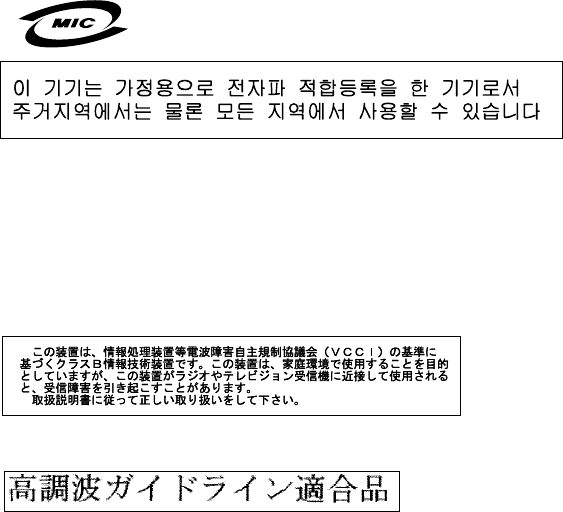
10
Europeiska unionen (EU)
Denna produkt har testats och följer gränsvärdena för Klass B Information Technology Equipment
enligt CISPR 22 Ú Europeisk standard EN55024:1998. Gränsvärden för Klass B-utrutning utgår frår
vanliga bostadsomräden för att ge ett rimligt skydd mot störningar i kommunikationsenheter.
Korrekt avskärmade och jordade kablar och kontakter måste användas för att minska risken för
störningar i radio- och TV-kommunikationer och annan elektrisk utrustning. Sådana kablar och
kontakter finns tillgängliga hos auktoriserade IBM-återförsäljare.
I enlighet med EN 55024:1998 1992, Performance Criterion A påpekas följande: I närheten av en del
elektromagnetiska fält kan vissa bildstörningar uppstår på skårmen.
Deutsche EMV-Direktive (electromagnetische Verträglichkeit)
Dieses Gerät ist berechtigt in Übereinstimmung mit dem deutschen EMVG vom 9.Nov.92 das EG-
Konformitätszeichen zu führen.
Der Aussteller der Konformitätserklärung ist die IBM UK, Greenock.
Dieses Gerät erfüllt die Bedingungen der EN 55022 Klasse B.
VCCI Class B Notice (Japan Only)
This equipment complies with the limits for a Class B digital device (devices used in or adjacent to a
residential environment) and conforms to the standards for information technology equipment that are
set by the Voluntary Control Council for Interference for preventing radio frequency interference in
residential areas.
Japanese statement of compliance for products less than or equal to 20 A per phase:
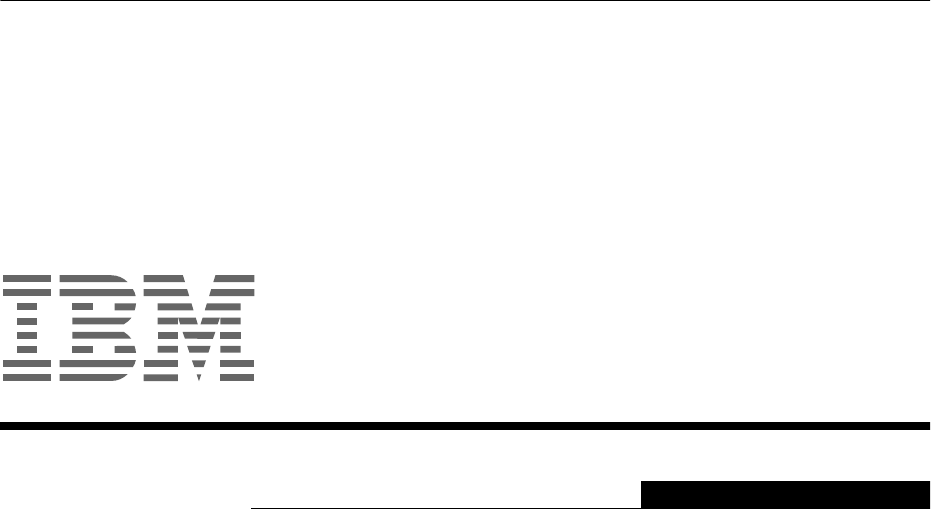
L170
User's Guide
IBM ThinkVisionTM Monitor L170
English

iii
First Edition (May/2004)
Note: For important information, refer to the Monitor Safety and Warranty manual that comes with this monitor.

ENGLISH
1
Safety (Read first).......................................................................................................2
Setting up the monitor ...............................................................................................5
Product description ..............................................................................................5
Handling instructions............................................................................................5
Kensington security slot.......................................................................................6
Workplace preparation.........................................................................................7
Adjusting the monitor position..............................................................................7
Working practices.................................................................................................8
Caring for your monitor ........................................................................................8
Connecting your monitor......................................................................................9
Switching on your monitor..................................................................................10
Device driver installation .........................................................................................11
Windows 95/98...................................................................................................11
Windows 2000/Me..........................................................................................................12
Windows XP ...................................................................................................................13
Automatic Image setup............................................................................................14
Image setup .......................................................................................................14
Image setup for DOS .........................................................................................15
Image setup for Windows 95, Windows 98, Windows 2000, Windows NT,
Windows Me, or Windows XP
..................................................................................
16
Manual Image setup .................................................................................................17
Adjusting your LCD monitor ...................................................................................18
User controls......................................................................................................18
On-screen display (OSD) controls .....................................................................19
Further information ..................................................................................................22
Display modes ...................................................................................................22
Power management...........................................................................................23
Product disposal ................................................................................................23
Troubleshooting .......................................................................................................24
Help and service information .............................................................................26
Specifications ...........................................................................................................27
Service information..................................................................................................28
Notices and trademarks...........................................................................................29
Contents
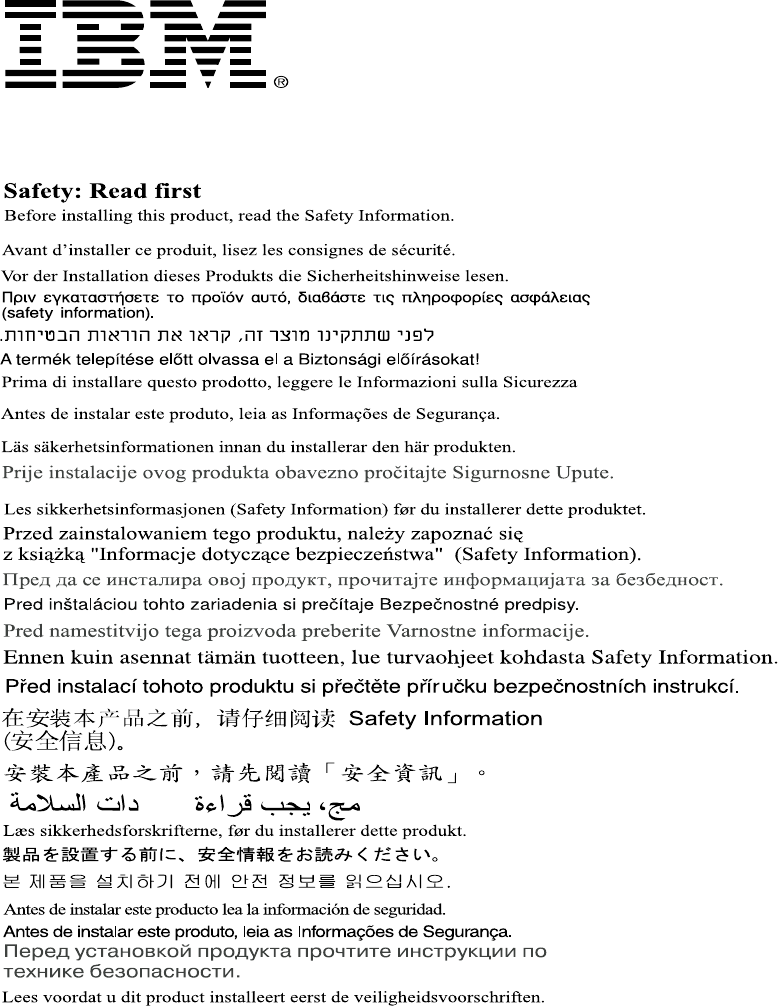
2

ENGLISH
3
Always observe the following precautions to reduce the risk of injury and property damage.
Do not attempt to service a product yourself unless instructed to do so by the IBM Support Center. Use
only an IBM authorized service provider who is approved to repair your particular product.
Note: Some parts can be upgraded or replaced by the customer. These parts are referred to as Customer
Replaceable Units, or CRUs. IBM expressly identifies CRUs as such, and provides documentation with
instructions when it is appropriate for customers to replace those parts. You must closely follow all
instructions when performing such replacements. Always make sure that the power is turned off and that
the product is unplugged from any power source before you attempt the replacement. If you have any
questions or concerns, contact the IBM Support Center.
Use only the power cords and power adapters supplied by the product manufacturer.
Never wrap a power cord around the power adapter or other object. Doing so can stress the cord in ways
that can cause the cord to fray, crack or crimp. This can present a safety hazard.
Always route power cords so that they will not be walked on, tripped over, or pinched by objects.
Protect the cord and power adapters from liquids. For instance, do not leave your cord or power adapter
near sinks, tubs, toilets, or on floors that are cleaned with liquid cleansers. Liquids can cause a short
circuit, particularly if the cord or power adapter has been stressed by misuse. Liquids can also cause
gradual corrosion of the power cord terminals and/or the connector terminals on the adapter which can
eventually result in overheating.
Always connect power cords and signal cables in the correct order and ensure that all power cord
connectors are securely and completely plugged into receptacles.
Do not use any power adapter that shows corrosion at the ac input pins and/or shows signs of
overheating (such as deformed plastic) at the ac input or anywhere on the power adapter.
Do not use any power cords where the electrical contacts on either end show signs of corrosion or
overheating or where the power cord appears to have been damaged in any way.
Ensure that extension cords, surge protectors, uninterruptible power supplies, and power strips that you
use are rated to handle the electrical requirements of the product. Never overload these devices. If power
strips are used, the load should not exceed the power strip input rating. Consult an electrician for more
information if you have questions about power loads, power requirements, and input ratings.
If a receptacle (power outlet) that you intend to use with your computer equipment appears to be damaged
or corroded, do not use the outlet until it is replaced by a qualified electrician.
Do not bend or modify the plug. If the plug is damaged, contact the manufacturer to obtain a replacement.
Some products are equipped with a three-pronged plug. This plug fits only into a grounded electrical
outlet. This is a safety feature. Do not defeat this safety feature by trying to insert it into a non-grounded
outlet. If you cannot insert the plug into the outlet, contact an electrician for an approved outlet adapter or
to replace the outlet with one that enables this safety feature. Never overload an electrical outlet. The
overall system load should not exceed 80 percent of the branch circuit rating. Consult an electrician for
more information if you have questions about power loads and branch circuit ratings.
4
Be sure that the power outlet you are using is properly wired, easily accessible, and located close to the
equipment. Do not fully extend power cords in a way that will stress the cords.
Connect and disconnect the equipment from the electrical outlet carefully
All IBM personal computers contain a non-rechargeable coin cell battery to provide power to the system
clock. In addition many mobile products such as ThinkPad notebook PCs utilize a rechargeable battery
pack to provide system power when in portable mode. Batteries supplied by IBM for use with your product
have been tested for compatibility and should only be replaced with IBM approved parts.
Never attempt to open or service any battery. Do not crush, puncture, or incinerate batteries or short
circuit the metal contacts. Do not expose the battery to water or other liquids. Only recharge the battery
pack strictly according to instructions included in the product documentation.
Battery abuse or mishandling can cause the battery to overheat, which can cause gasses or flame to
"vent" from the battery pack or coin cell. If your battery is damaged, or if you notice any discharge from
your battery or the buildup of foreign materials on the battery leads, stop using the battery and obtain a
replacement from the battery manufacturer.
Batteries can degrade when they are left unused for long periods of time. For some rechargeable batteries
(particularly Lithium Ion batteries), leaving a battery unused in a discharged state could increase the risk
of a battery short circuit, which could shorten the life of the battery and can also pose a safety hazard.
Do not let rechargeable Lithium-Ion batteries completely discharge or store these batteries in a discharged
state.
Computers generate heat when turned on and when batteries are charging. Notebook PCs can generate a
significant amount of heat due to their compact size. Always follow these basic precautions:
• Do not leave the base of your computer in contact with your lap or any part of your body for an
extended period when the computer is functioning or when the battery is charging. Your computer
produces some heat during normal operation. Extended contact with the body could cause discomfort
or, potentially, a skin burn.
• Do not operate your computer or charge the battery near flammable materials or in explosive
environments.
• Ventilation slots, fans and/or heat sinks are provided with the product for safety, comfort, and reliable
operation. These features might inadvertently become blocked by placing the product on a bed, sofa,
carpet, or other flexible surface. Never block, cover or disable these features.
CD and DVD drives spin discs at a high speed. If a CD or DVD is cracked or otherwise physically damaged,
it is possible for the disc to break apart or even shatter when the CD drive is in use. To protect against
possible injury due to this situation, and to reduce the risk of damage to your machine, do the following:
• Always store CD/DVD discs in their original packaging
• Always store CD/DVD discs out of direct sunlight and away from direct heat sources
• Remove CD/DVD discs from the computer when not in use
• Do not bend or flex CD/DVD discs, or force them into the computer or their packaging
• Check CD/DVD discs for cracks before each use. Do not use cracked or damaged discs
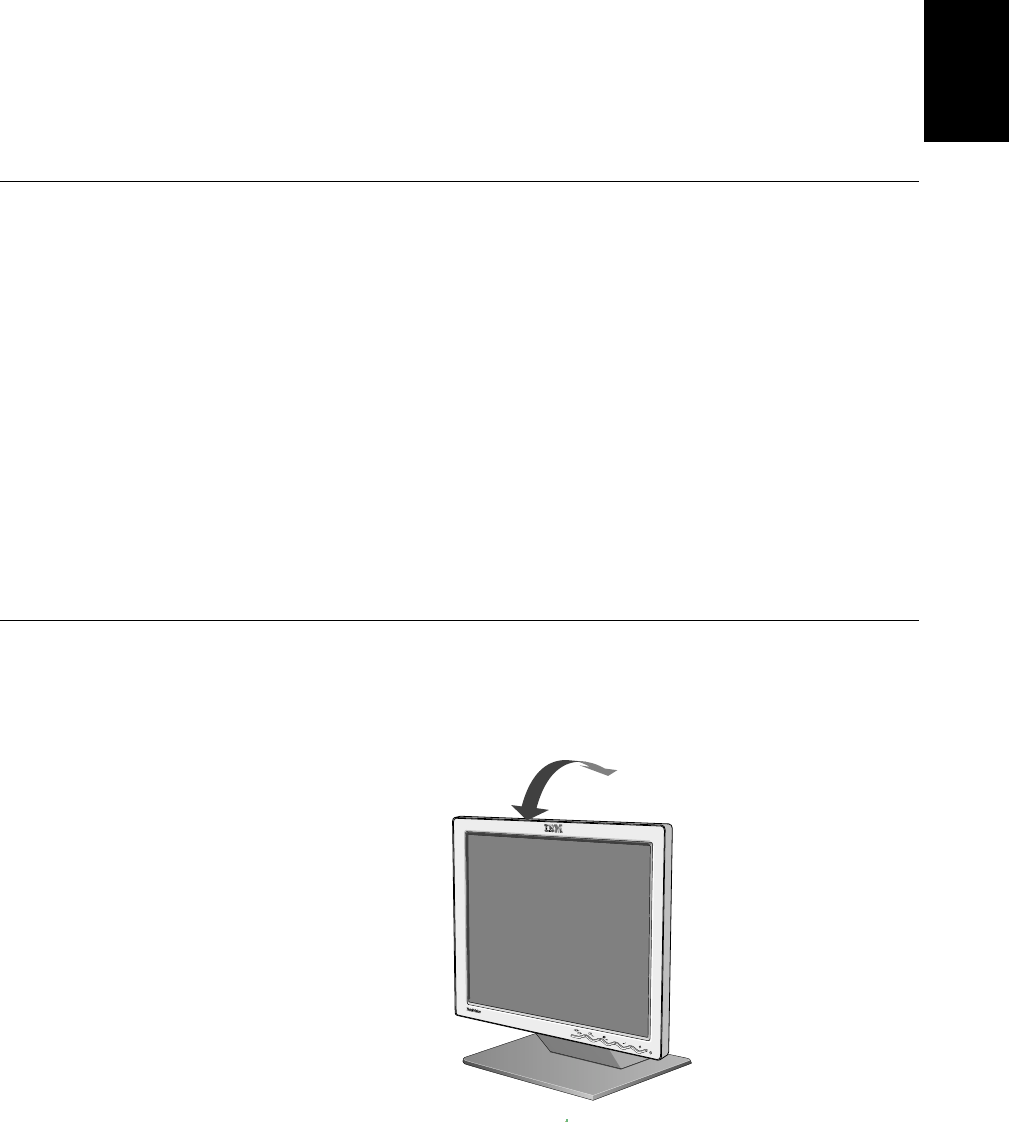
ENGLISH
5
Setting up the monitor
Handling instructions
1. Lift the monitor by placing your hands where indicated by the arrows in
the figure below.
2. Before using your monitor for the first time, remove the clear protective
film from the front of the screen.
Product description
The IBM ThinkVision Monitor, L170, is a TFT LCD Color Monitor.
It requires a computer with a suitable on-board sub-system or Video
Adapter card that can support SXGA 1280 x 1024, XGA 1024 x 768, SVGA
800 x 600, or VGA 640 x 480 at 60Hz.
In addition to your monitor, your option package includes the following:
•User's Guide and Installation Files CD
•Monitor Safety and Warranty Information Manual
•IBM ThinkVision Monitor L170 Setup Guide
•Power Cord
•L170 ThinkVision Monitor
•Analog Interface Cable - Attached to Monitor
Do not support the monitor within
the screen area. The Liquid
Crystal Display is glass and can
be damaged by rough handling or
excessive pressure.
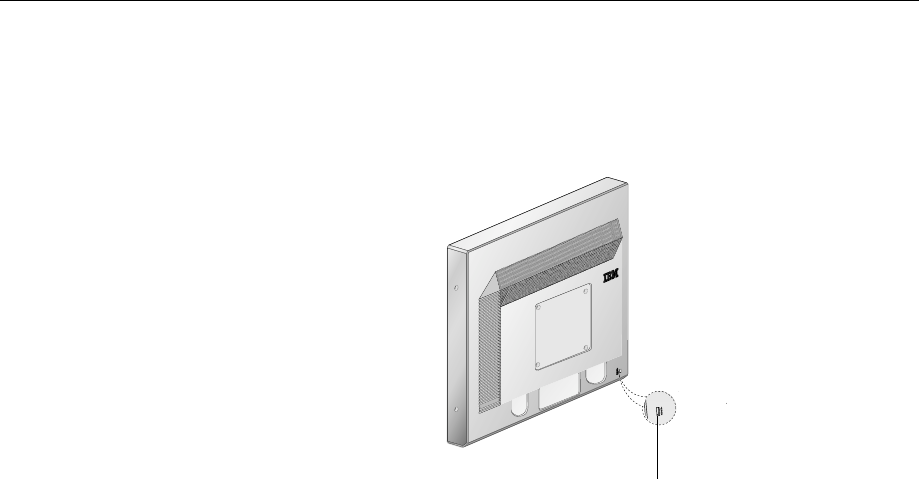
6
Kensington security slot
This slot can be used to connect to a locking cable. Locking cables can be
purchased separately at most computer stores.
Kensington
security slot
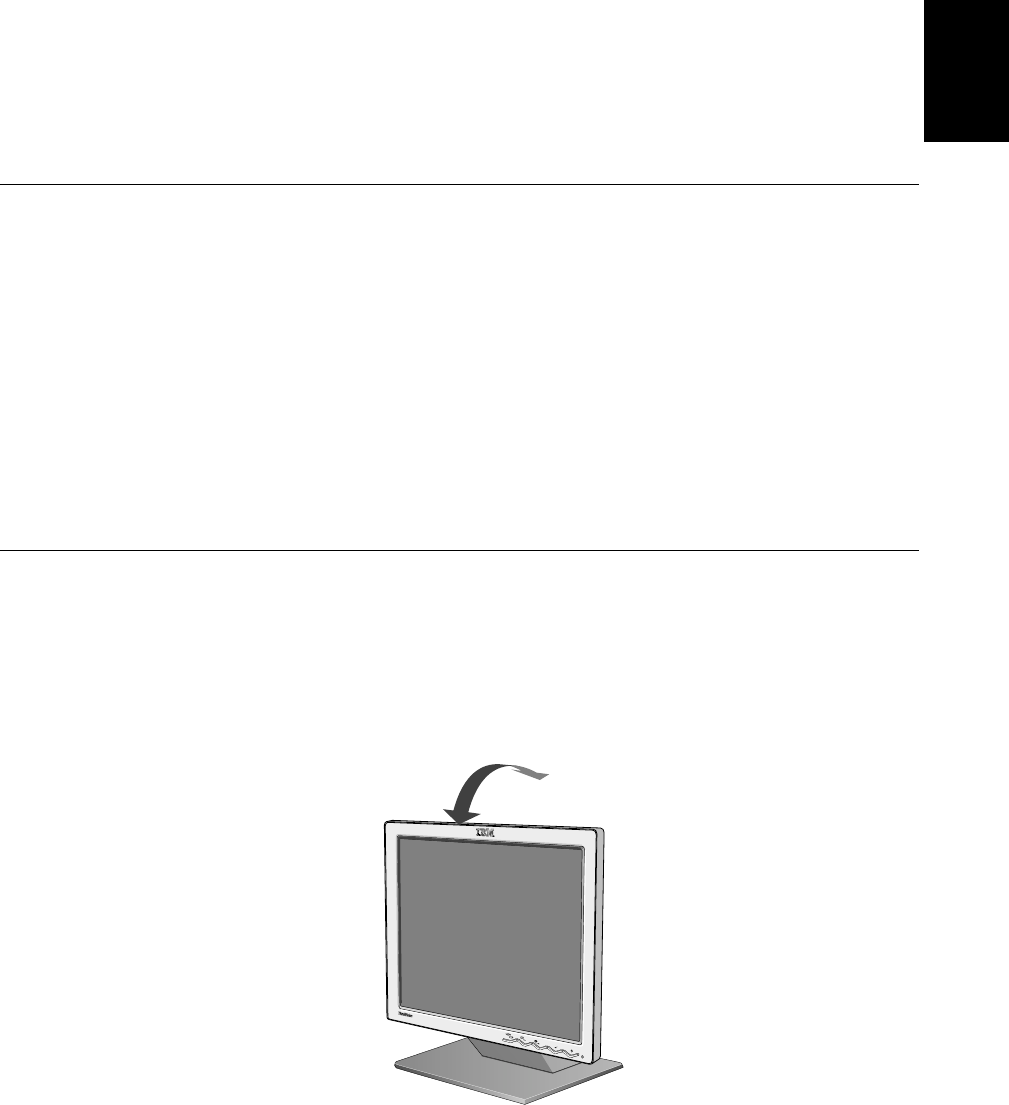
ENGLISH
77
i
With the IBM Flat Panel
Monitor, you can adjust its
position in various ways for
maximum comfort.
Viewing angle
You can tilt the screen forward and backward as shown below in Figure A.
Figure A
Adjusting the monitor position
i
This section gives advice
on what you should
consider before you set up
your monitor.
Workplace preparation
Height
Position the monitor so that the top of the screen is slightly below your eye
level when you sit at your workstation.
Orientation
1. Choose a position that gives the least reflection from lights and windows,
usually at a right angle to any windows.
2. Positon the monitor directly in front of you so that you do not have to twist
your body to use it.
3. Tilt the monitor to a comfortable viewing angle.

8
Be sure to turn off the power before you perform any maintenance on the
monitor. Clean your monitor as follows:
• Do not use solvents or abrasives.
• Gently wipe the covers and the screen with a soft cloth.
• Remove finger marks and grease with a damp cloth and mild detergent.
• Never use flammable cleaning materials to clean your IBM monitor or
any other electrical apparatus.
Caring for your monitor
i
This section gives advice
on how you can work
comfortably and reduce
fatigue.
Rest
Take regular breaks. Vary your posture, stand up and stretch occasionally
as prolonged use of computer workstations can be tiring.
Back
Sit back in your chair and use the backrest.
Hands
Use a light touch on the keyboard and keep your hands and fingers
relaxed. Your upper arms should be relaxed with your elbows near your
body.
Use a light touch on the keyboard, keeping your hands and fingers relaxed.
Allow a space in front of the keyboard to rest your wrists when not typing.
Consider using a wristpad.
Eyesight
Working with monitors, in common with any prolonged close work, can be
visually demanding. Look away from the screen periodically and have your
eyesight checked regularly.
Screen settings
Set the screen brightness and contrast to a comfortable level. You may
have to adjust these settings as the lighting changes during the day. Many
application programs let you select color combinations which can help you
to view in comfort. See the User controls section on page 18 for more
information.
Working practices
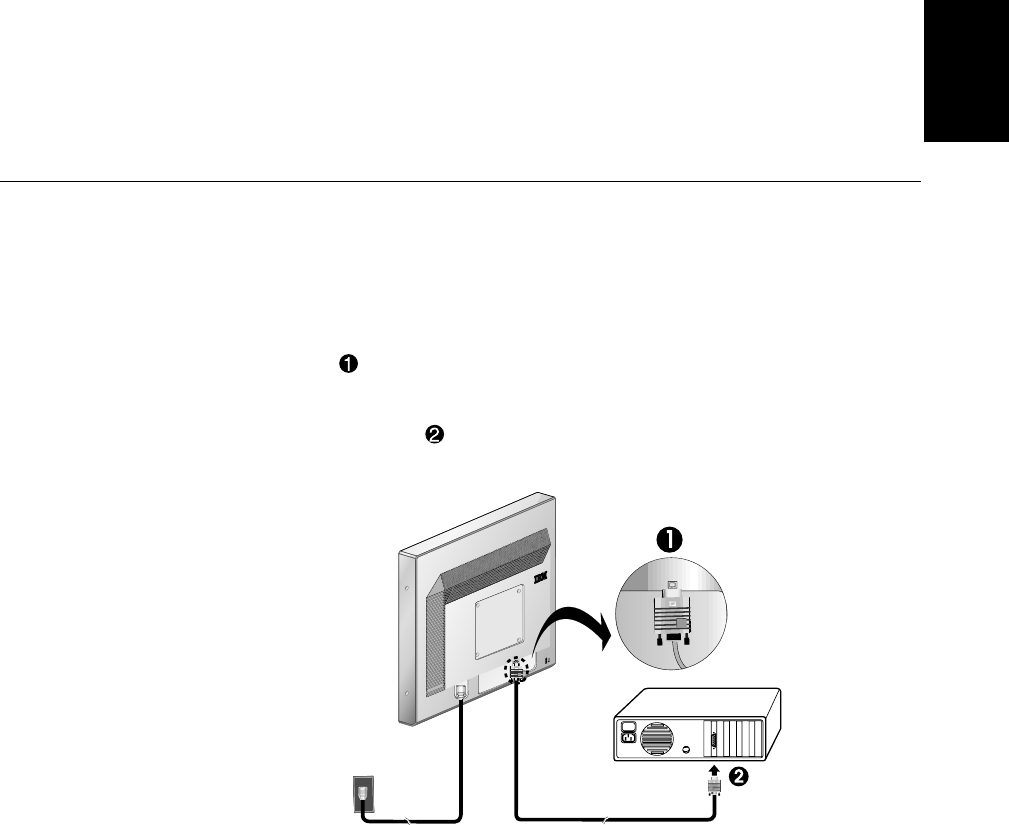
ENGLISH
9
Connecting your monitor
1. Turn off your computer and all attached devices. Next, unplug all power
cords to your computer and all attached devices.
2. Connect the signal cable.
• The analog signal cable is already connected to your monitor
(See in Figure A).
• When connecting the analog signal cable, connect the free end of the
attached signal cable to the 15-pin monitor port on the computer and
tighten screws.
Figure A
Be sure to read the Safety
Information located in the
Monitor Safety and Warranty
Information Manual before
carrying out this procedure.

10
1. Switch on your computer.
2. Switch on your monitor by pushing and releasing the power switch marked " "
at the front of the bezel.
• To switch off your monitor, push and release the power switch again.
3. To update or install device drivers, follow the instructions in the Device driver
installation section on page 11.
4. If you are using the analog connector, run Image setup by following the
instructions in the Automatic Image setup section on page 14.
Switching on your monitor
3. Connect the power cord to the monitor and then plug the power cord into a
properly grounded outlet. Next, reconnect the power cords to your computer
and all attached devices.

ENGLISH
11
To install the device driver in Microsoft
®
Windows
®
95 or Windows 98, do
the following:
Note:
You must download files from the User’s Guide and Installation Files CD to
use the Plug and Play feature in Windows 95 or Windows 98.
1. Turn off the computer and all attached devices.
2. Ensure that the monitor is connected correctly.
3. Turn on the monitor and then the system unit. Allow your computer to
start the Windows 95 or Windows 98 operating system.
Your computer’s Plug and Play code might warn you that your system
hardware has changed. This means that it has detected your new
monitor for the first time.
4. Open the Display Properties window by clicking Start -> Settings ->
Control Panel and then double-clicking on the Display icon.
5. Click the Settings tab.
6. If you are using Windows 95, complete the following steps:
a. Click the Change Display Type button.
b. Click the Change Monitor Type button.
c. Proceed to Step 7.
If you are using Windows 98, complete the following steps:
a. Click the Advanced button.
b. Click the Monitor tab.
c. Open the Update Device Driver Wizard window by clicking on the
Change button and then select the Next button.
d. Select Display a list of the known drivers for this device so that
I can choose a specific driver and then select the Next button.
e. Proceed to Step 7.
7. Insert the User’s Guide and Installation Files CD into the CD drive and
click the Have Disk button.
8. Click OK.
9. Ensure that the CD drive letter is selected, and then select the
DRIVERS folder.
10. Select IBM L170 monitor and click OK. The files will be copied from
the CD to your hard disk drive.
11. Close all open windows and remove the CD.
12. Restart the computer.
The system will automatically select the maximum refresh rate and
corresponding Color Matching Profiles.
Device driver installation
Installing the device driver in Windows 95 or Windows 98
This section must be
completed before
continuing with the
Windows 95 or Windows 98
Image setup on page 14.
i
On LCD monitors, unlike
CRTs, a faster refresh rate
does not improve display
quality. For optimal
performance, use either 1280 x
1024 at a refresh rate of 60Hz
or 640 x 480 at a refresh rate
of 60Hz.

12
To install the device driver in Microsoft Windows 2000 Professional or
Microsoft Windows Millennium Edition (Me), do the following:
Note:
You must download files from the User’s Guide and Installation Files CD to
use the Plug and Play feature in Windows 2000 or Windows Me.
1. Turn off the computer and all attached devices.
2. Ensure that the monitor is connected correctly.
3. Turn on the monitor and then the system unit. Allow your computer to
start the Windows 2000 or Windows Me operating system.
4. Open the Display Properties window by clicking Start -> Settings ->
Control Panel and then double-clicking on the Display icon.
5. Click the Settings tab.
6. Click the Advanced button.
7. Click the Monitor tab.
8. Click the Properties button.
9. Click the Driver tab.
10. Open the Upgrade Device Driver Wizard window by clicking on
Update Driver and then click the Next button.
11. Select Display a list of the known drivers for this device so that
I can choose a specific driver and then click the Next button.
12. Insert the Monitor CD into the CD drive and click the Have Disk button.
13. Click OK.
14. Ensure that the CD drive letter is selected, and then select the
DRIVERS folder.
15. Select IBM L170 monitor and click OK. The files will be copied from
the CD to your hard disk drive.
16. Close all open windows and remove the CD.
17. Restart the computer.
The system will automatically select the maximum refresh rate and
corresponding Color Matching Profiles.
Installing the device driver in
Windows 2000 or Windows Me
This section must be
completed before
continuing with the
Windows 2000, Windows Me
Image setup on page 14.
i
On LCD monitors, unlike
CRTs, a faster refresh rate
does not improve display
quality. For optimal
performance, use either 1280 x
1024 at a refresh rate of 60Hz
or 640 x 480 at a refresh rate
of 60Hz.

ENGLISH
13
To install the device driver in Windows XP, do the following:
Note:
You must download files from the User’s Guide and Installation Files CD to
use the Plug and Play feature in Windows XP.
1. Turn off the computer and all attached devices.
2. Ensure that the monitor is connected correctly.
3. Turn on the monitor and then the system unit. Allow your computer to
start the Windows XP operating system.
4. Open the Display Properties window by clicking Start -> Settings ->
Control Panel and then double-clicking on the Display icon.
5. Click the Settings tab.
6. Click the Advanced button.
7. Click the Monitor tab.
8. Click the Properties button.
9. Click the Driver tab.
10. Open the Hardware Update Wizard window by clicking on Update
Driver and then click the Next button.
11. Select Install from a list or Specific location(Advanced) and then
click the Next button.
12. Insert the Monitor CD into the CD drive and click the Have Disk button.
13. Click OK.
14. Ensure that the CD drive letter is selected, and then select the
DRIVERS folder.
15. Select IBM L170 monitor and click OK. The files will be copied from
the CD to your hard disk drive.
16. Close all open windows and remove the CD.
17. Restart the computer.
The system will automatically select the maximum refresh rate and
corresponding Color Matching Profiles.
Installing the device driver in
Windows XP
This section must be
completed before
continuing with the
Windows XP Image Setup on
page 14.
i
On LCD monitors, unlike
CRTs, a faster refresh rate
does not improve display
quality. For optimal
performance, use either 1280 x
1024 at a refresh rate of 60Hz
or 640 x 480 at a refresh rate
of 60Hz.

14
For digital input, image setup is not required.
When you first use your monitor, you must perform Auto Setup for analog
input. If you are using digital input, continue with the instructions on page 9.
This procedure sets up your monitor to process the video signals from your
computer without image discoloration or smearing. After you perform Auto
Setup, the settings are stored and used each time you turn on the monitor.
In order to optimize the displayed image a set-up utility is provided on the
IBM Monitor CD. Operation of this utility is dependent on the operating
system on your computer. You may choose to run Image setup for each
operating system that you use. This means that if you sometimes use your
monitor while running any version of Windows and sometimes also use it
from within DOS (not a DOS window), you must run Image setup for both
Windows and DOS. You may run versions of Image setup in any order.
Before you begin
Image setup
for your computer, make sure the
computer video mode is set in the range of the supported screen
resolution shown in the table on page 22.
You should perform
Image setup
for each screen mode you use.
Automatic Image setup
Image setup
Before carrying out this
section, it is very important
that the correct monitor
drivers have been installed.
(See pages 11 and 13. )
i
The Setup Utility included
on the setup CD displays a
test pattern of dots. It does not
replace or modify the display
drivers.
i
The Image setup
instructions require the
monitor to be warmed up for 15
minutes. This is not required
for normal operation.
i
If your computer does not
run with the setup CD
shipped with the monitor, refer
to Manual Image setup on
page 17.
i
The Image setup process
only applies to the current
screen mode. When a new
mode is selected, repeat this
section to reset the monitor.
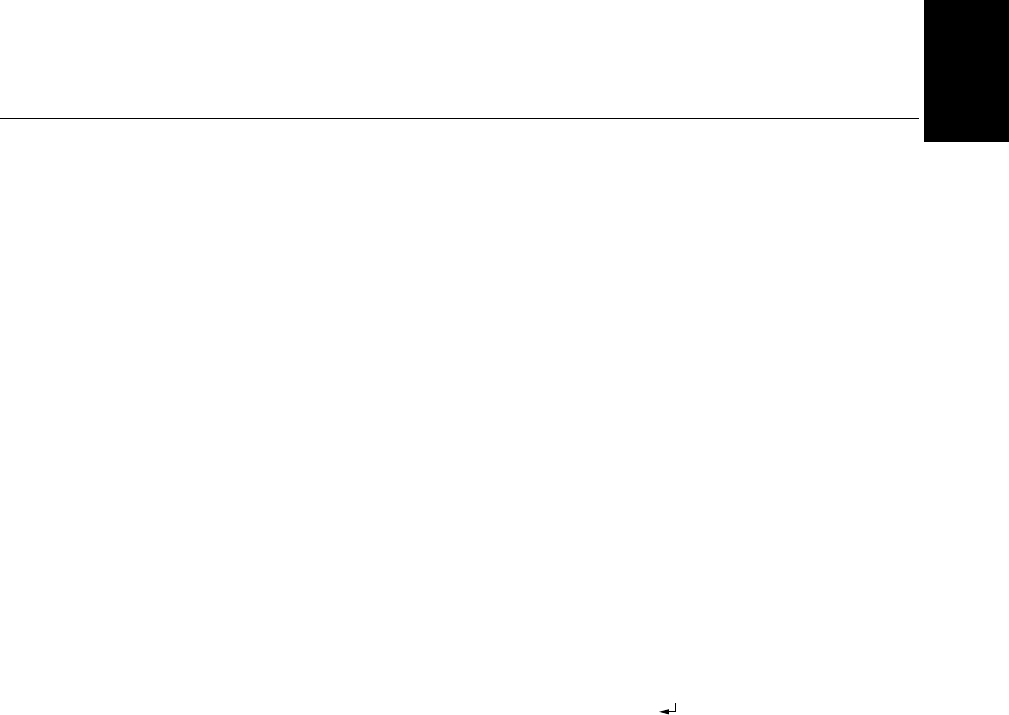
ENGLISH
15
Image setup for DOS
i
If the monitor is in standby
mode, it may automatically
turn off while you are waiting for
it to warm up. If this happens,
switch off the monitor and
switch it on again after a few
seconds.
i
If you are using PC-DOS/V,
change to U.S. mode by
typing CHEV US and pressing
enter at the command prompt.
i
The size and diversity of the
dot pattern varies with the
screen resolution.
i
If the screen flickers, repeat
the setup several times until
the flicker is minimized, or
adjust it manually by following
refer to Manual Image setup on
page 17.
To set up the monitor automatically in DOS, do the following.
1. Turn on the monitor first; then turn on the computer.
If the message "check signal cable" is displayed, or if nothing is
displayed, check:
• That the video interface cable is not connected properly.
• The correct video adapter card is not installed.
• The correct supported display mode is selected for your computer.
2. Wait approximately 15 minutes for the monitor to warm up.
3. Insert the User's Guide and Installation Files CD into the computer's
CD-ROM drive.
4. Display the command prompt screen of the DOS full-screen display.
5. Type d:\TESTPAD where d is the letter of the CD-ROM drive.
6. Press enter.
7. Select the number for the color or text mode you want to set up.
8. Select the number for the video mode you want to set up. You can
repeat this process for as many of the color and video modes as you
need.
9. When the dot pattern appears, press the " " button at the bottom of
the monitor. This activates the Auto setup procedure, which will
optimize the display settings with the provided dot-patterns.
The screen will momentarily turn black while auto adjustment proceeds.
10. When finished, the Image setup message disappears and the screen
returns to a normal display.
11. To clear the Image setup test pattern, press the Esc key on your
keyboard.
12. Type Exit at the command prompt to return to Windows.
If you use other operating systems, perform the appropriate Auto setup for
those systems using instructions given in
Image setup Windows 95, Windows 98, Windows NT, Windows 2000,
Windows Me, or Windows XP on page 16.
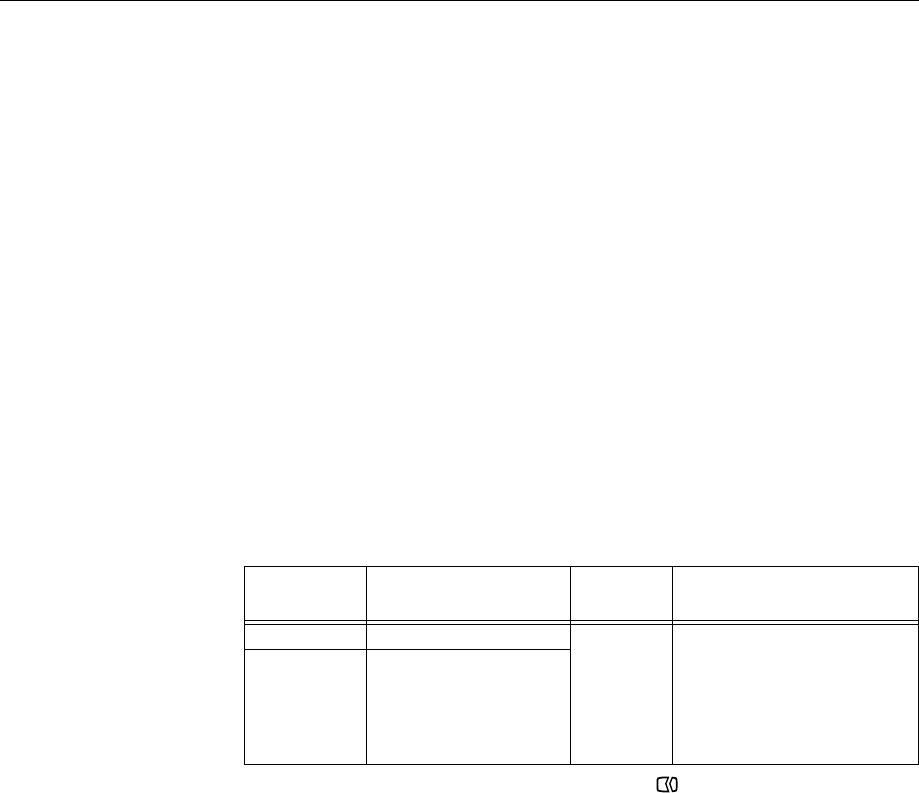
6. When the dot pattern appears, press the " " button at the bottom of
the monitor. This activates the Image setup procedure, which will
optimize the display settings with the provided dot-patterns.
•The screen will momentarily turn black while auto adjustment
proceeds.
7. When finished, the Image setup message disappears and the screen
returns to a normal display.
8. To clear the Image setup test pattern, press the Esc key on your
keyboard.
You have completed the monitor setup for Windows. If you are using the
DOS operating system, go to "Image setup for DOS on page" 15.
1616
To set up the monitor automatically in Windows 95, Windows 98, Windows
NT, Windows 2000, Windows Me, or Windows XP, do the following:
1. Turn on the monitor first; then turn on the computer.
If the message "check signal cable" is displayed, or if nothing is
displayed, check:
• That the video interface cable is not connected properly.
• The correct video adapter card is not installed.
• The correct supported display mode is selected for your computer.
2. Wait approximately 15 minutes for the monitor to warm up.
3. If the icon bar and tool bar are displayed, drag them to the bottom of the
screen.
4. Insert the User's Guide and Installation Files CD into the computer's
CD-ROM drive.
5. Check the operating system installed on your computer and follow the
instructions from the table below.
i
If the monitor is in standby
mode, it may automatically
turn off while you are waiting for
it to warm up.
i
The size and diversity of the
dot pattern varies with the
screen resolution.
Step 1
Select
START
Open program manager
Select
RUN
Type e:\TESTPAT where e is
the letter of your CD-ROM drive,
then press Enter.
Step 2 Step 3
Operating
System
Image setup for Windows 95, Windows 98, Windows NT, Windows 2000,
Windows Me, or Windows XP
Operating system installation steps
Windows 95
Windows 98,
Windows 2000,
Windows NT,
Windows Me or
Windows XP
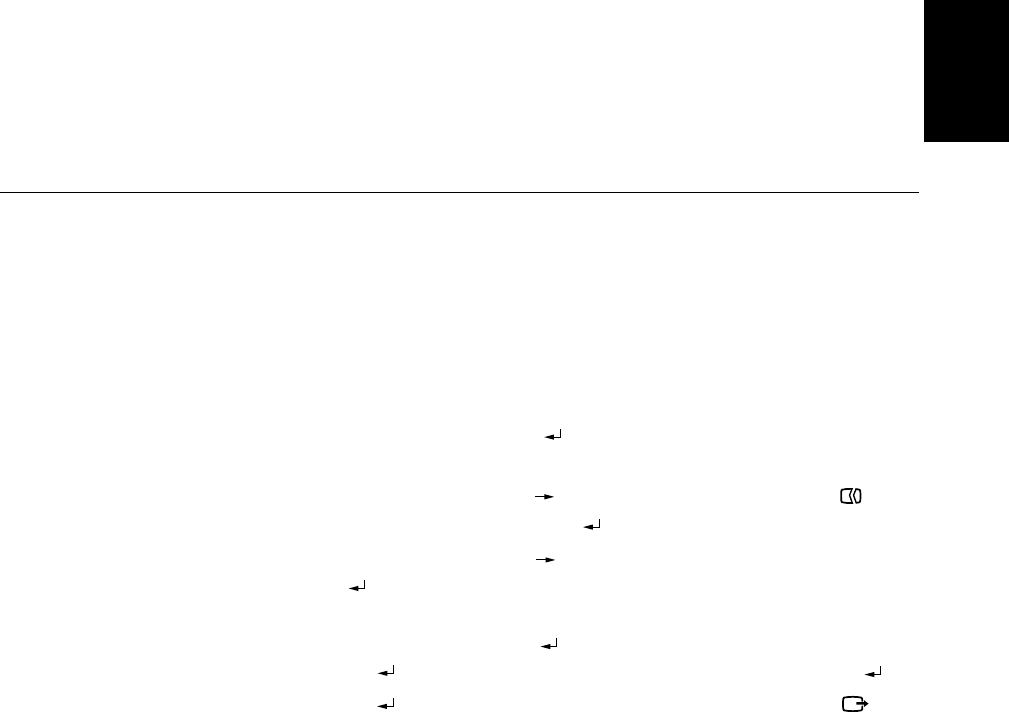
Normally, you can complete the setup procedure using Automatic Image setup;
however, if your screen image is still distorted after you perform Image setup or
the setup CD does not run on your system, perform Manual Image setup.
To manually adjust the image setting, do the following:
1. Turn on the monitor and wait approximately 15 minutes for it to warm
up.
2. Display the image you most frequently use on the screen.
3. Press the OSD Enter button " " at the bottom of the monitor to display
the initial OSD menu.
4. Use the Right Arrow button " " to select the Image setup icon " "
and press the OSD Enter button " " to access the function.
5. Use the Right Arrow button " ", to select to manual. Press the OK
button " " twice to select clock.
6. Use the Arrow buttons to manually adjust to correct for jitter or noise in
the image. Press OK button " ".
7. Press OK " " and use Arrow buttons to adjust phase, press OK " ".
Press OK " " again to Save and Exit. Then press Exit button " "
twice to exit OSD.
You have completed the monitor setup.
ENGLISH
17
i
If the monitor is in standby
mode, it might automatically
turn off while you are waiting
for it to warm up.
Manual Image setup
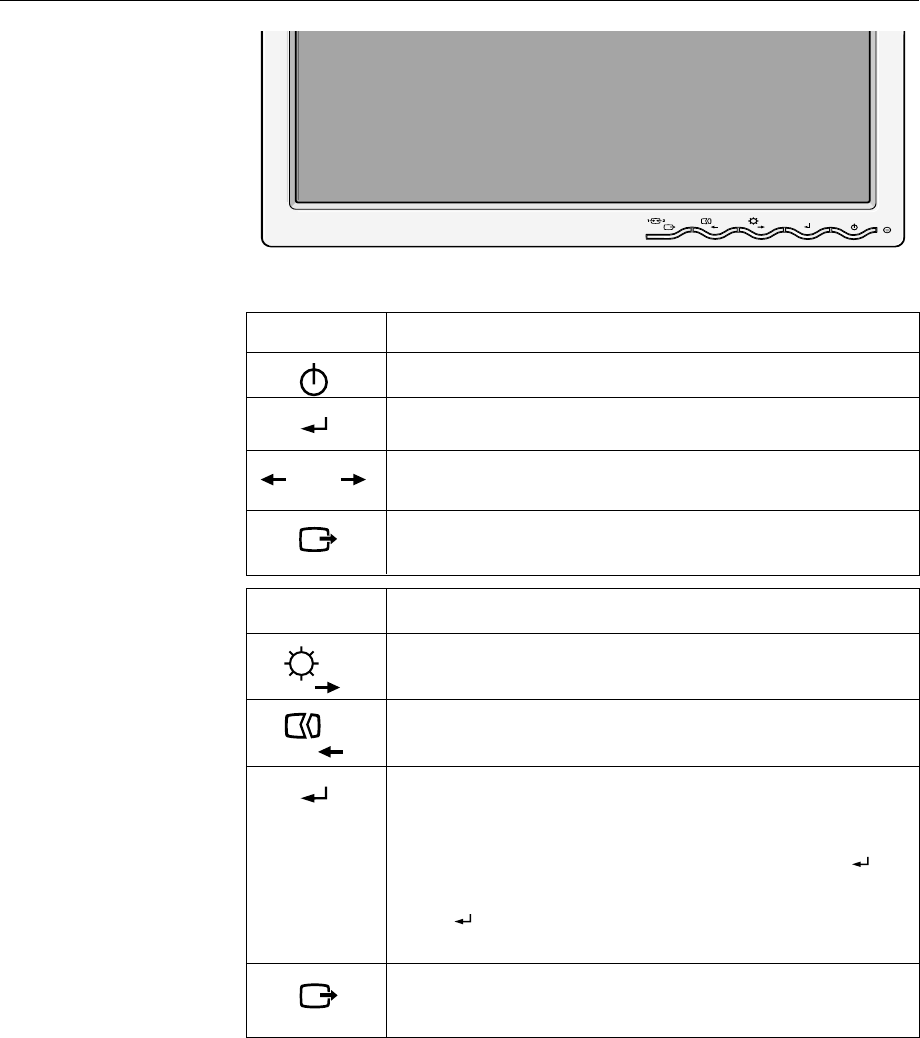
18
Adjusting your LCD monitor
User controls
USER CONTROL FEATURES
i
The image is already
optimized for many display
modes, however the user
controls can be used to adjust
the image to your liking.
i
The settings are saved
after adjustment and
when exiting the OSD and
will be effective thereafter.
ThinkVision
Icon Direct Access Functions
Switches the monitors on and off.
Bring up Brightness adjustment.
Executes automatic image setup.
Exits from current OSD menu.
Icon Monitor controls
and
Display main OSD menu and selects highlighted menu item.
Moved the cursor to highlight icons or make adjustments.
Exits from current OSD menu.
CONTROLS LOCK / UNLOCK
This feature allows you to secure the current control settings,
while allowing the user to adjust Brightness, so that they cannot
be inadvertently changed. Push and hold the enter button[ ] for
10 seconds; the message “Menu is Locked” appears.
You can unlock the OSD controls at any time by pushing the enter
button[ ] for 10 seconds; the message “Menu is Unlocked” will
appear.
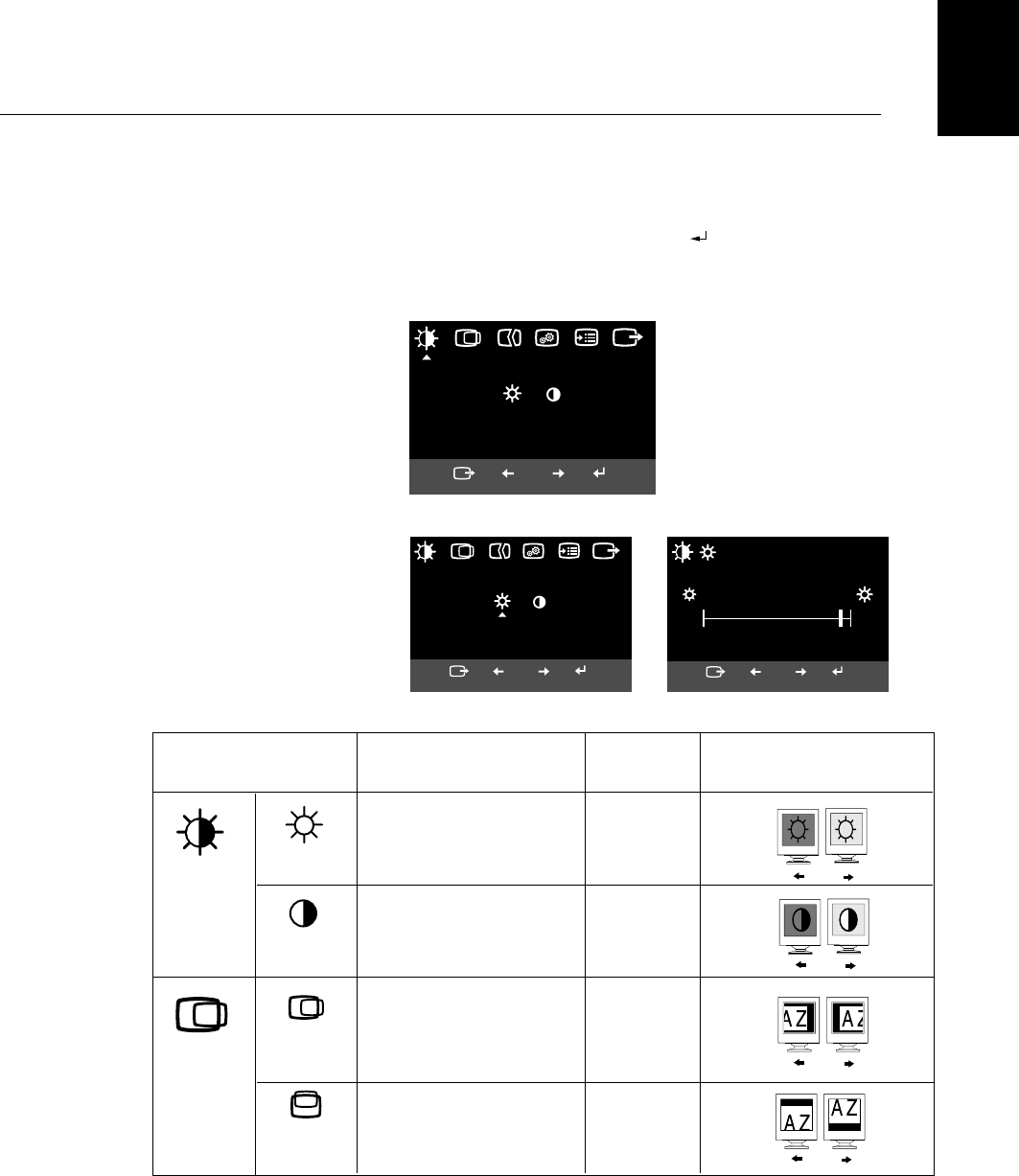
ENGLISH
19
The settings adjustable with the user controls are viewed through the On -
Screen Display (OSD). Press the enter button ""to display the main OSD
menu.
Initial appearance of OSD
On-screen display (OSD) controls
i
The LCD monitor needs
time to become thermally
stable the first time you turn it
on each day. Thus, to achieve
more accurate adjustments for
parameters, allow the LCD
monitor to warm up for at least
15 minutes before making any
screen adjustment.
Brightness/Contrast
Exit OK
Brightness/Contrast
Brightness:
Adjusts overall screen brightness.
Cancel OK
Brightness
0
92
100
Cancel OK
OSD functions
OSD Icon Description Sub menus Control and Adjustments
Adjusts brightness
Adjusts contrast
Brightness
Contrast
Sub menu Adjustment screen
Main menu
Horizontal
Position
Vertical
Position
Moves the screen left and right.
Moves the screen up and down.
Brightness /
Contrast
Image
Position
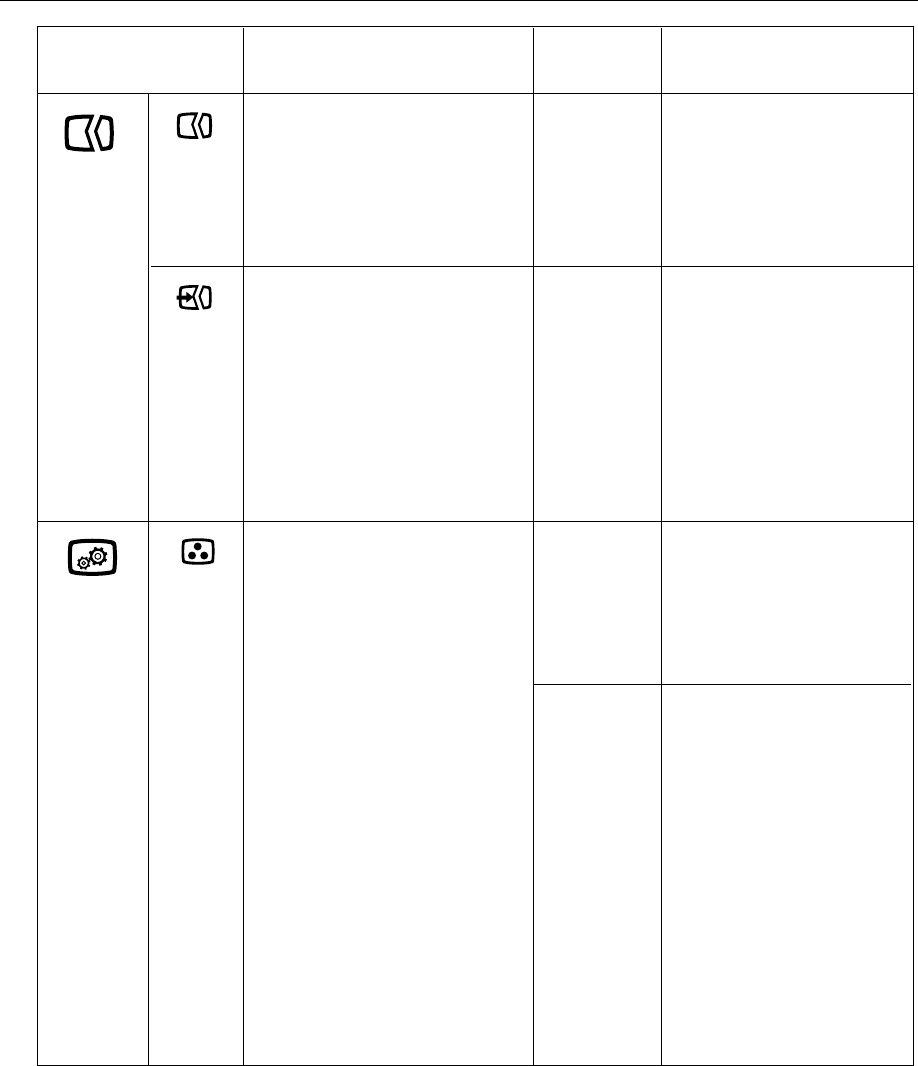
20
OSD Icon
Select the Color mode you find most
comfortable or fine tune the colors
using the Custom menu, if necessary.
Description Sub-menu(s) Control and Adjustments
• Clock
• Phase
• Save
Increases or decreases redness
Increases or decreases
greenness
Increases or decreases
blueness
Preset
•
6500K
(Pink White)
•
7200K
(Normal White)
•
9300K
(Blue White)
Custom
•
R
•
G
•
B
•
Save
To adjust the focus of the display.
This item allows you to remove
any horizontal noise and clear or
sharpen the image of characters.
If manual is selected, the user will go
to the manual adjustment screen.
If Auto is selected the image
will automatically adjust
The Image setup function is used to
adjust the level of noise in the video
signal which causes horizontal lines or
areas on the screen where the image
appears to be unstable and jitters or
shimmers. This can be done
automatically or manually.
Automatic
Manual
Color
Image Setup
Image
Properties
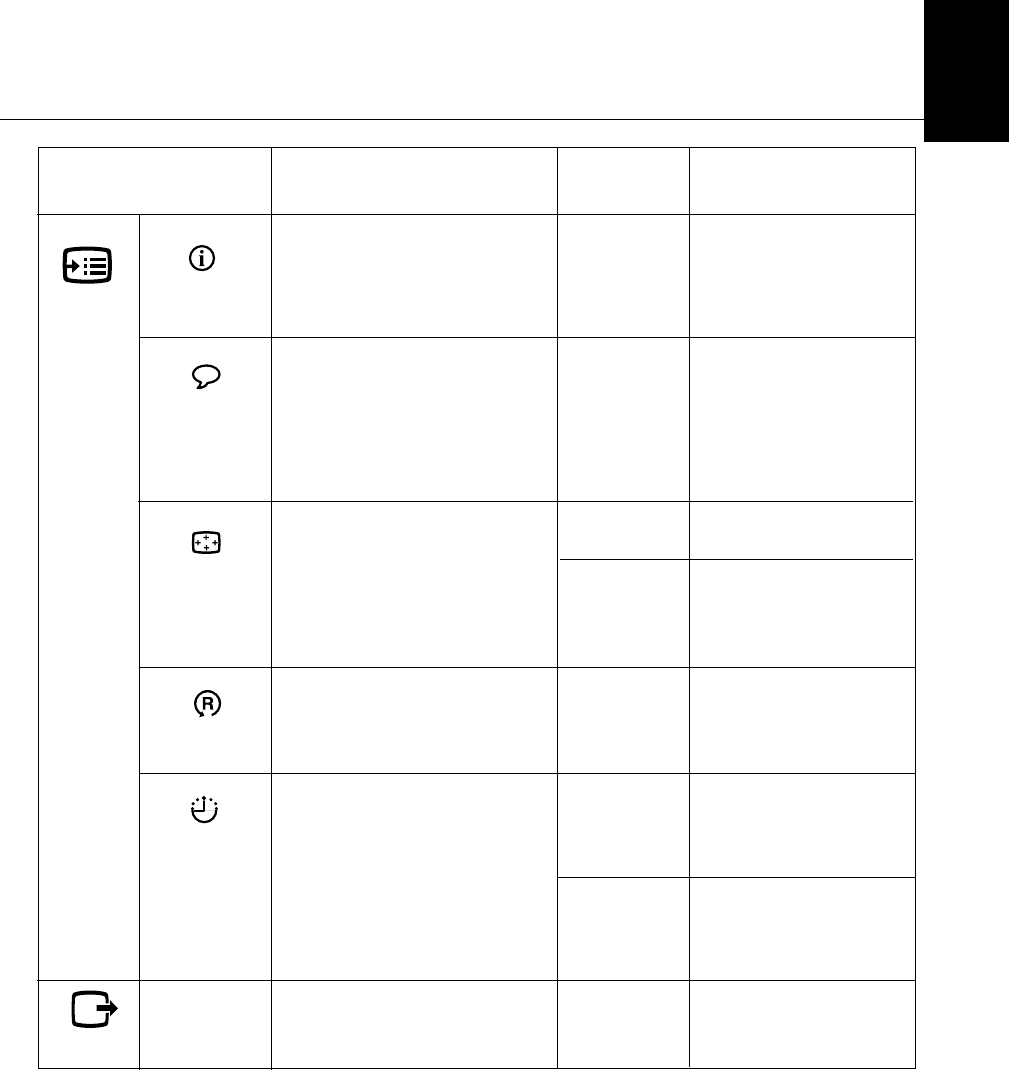
ENGLISH
21
• English
• Français
• Italiano
• Deutsch
• Español
OSD Icon
Display the detailed information of
mode, model name, serial number
and microcode.
Description Sub-menu(s)
Move at center on the screen.
Adjusts respondence speed
of button.
Adjusts the length of time for
which the menu will stay on
the screen before it
disappears.
• Default
Custom
•
H
•
V
•
Save
Information
The language chosen affects only the
language of the OSD.
Select one of the five language to use
for the OSD.
It has no effect on any software
running on the computer.
Language
Changes the position of the OSD on
the screen.
Menu Position
• Cancel
• Reset
Reset should return all available
functions (apart from language which
should not change unless adjusted
via the Language menu) to their
factory presets.
Exits from current OSD menu.
Reset
Button
repeat rate
•
Off
•
Default
•
Slow
Menu time out
Change button repeat rate and menu
time-out setting.
Accessibility
Options
Exit
Controls and Adjustments

22
i
If your computer has
previously been used with
a CRT monitor and is currently
configured to a display mode
outside the range that the Flat
Panel monitor can display, you
may need to re-attach the CRT
monitor temporarily until you
have reconfigured the
computer, preferably to 1280 x
1024 at 60Hz.
The display mode the monitor uses is controlled by the computer.
Therefore, you should refer to your computer documentation for details on
how to change display modes.
The image size, position and shape may change when the display mode
changes. This is normal and the image can be readjusted using Image
setup and the monitor controls.
Unlike CRT monitors, which require a high refresh rate to minimize flicker,
TFT technology is inherently flicker-free. If possible, configure your
computer for 1280 x 1024 addressability at 60Hz vertical refresh rate.
For the display modes listed below, the screen image has been optimized
during manufacture.
Factory Set Display Modes
Further information
Display modes
Addressability Refresh Rate Horizontal Frequency
640 x 350 70.8 Hz 31.5 kHz
640 x 480 59.9 Hz 31.5 kHz
640 x 480 66.6 Hz 35.0 kHz
640 x 480 72.8 Hz 37.8 kHz
640 x 480 75.0 Hz 37.5 kHz
720 x 400 70.1 Hz 31.5 kHz
800 x 600 60.3 Hz 37.8 kHz
800 x 600 72.1 Hz 48.0 kHz
800 x 600 75.0 Hz 46.8 kHz
832 x 624 74.5 Hz 49.7 kHz
1024 x 768 60.0 Hz 48.3 kHz
1024 x 768 70.0 Hz 56.4 kHz
1024 x 768 75.0 Hz 60.1 kHz
1024 x 768 74.9 Hz 60.2 kHz
1152 x 864 75.0 Hz 67.5 kHz
1152 x 870 75.0 Hz 68.6 kHz
1152 x 900 65.9 Hz 61.8 kHz
1280 x 960 60.0 Hz 60.0 kHz
1280 x 1024 † 60.0 Hz 63.9 kHz
1280 x 1024 72.0 Hz 78.1 kHz
1280 x 1024 75.0 Hz 79.9 kHz
† Recommended
Note: VESA timings are as
detailed in the VESA
“Display Monitor Timing
Specification”. Version 1.0,
Revision 0.8, Dated
09/17/98.
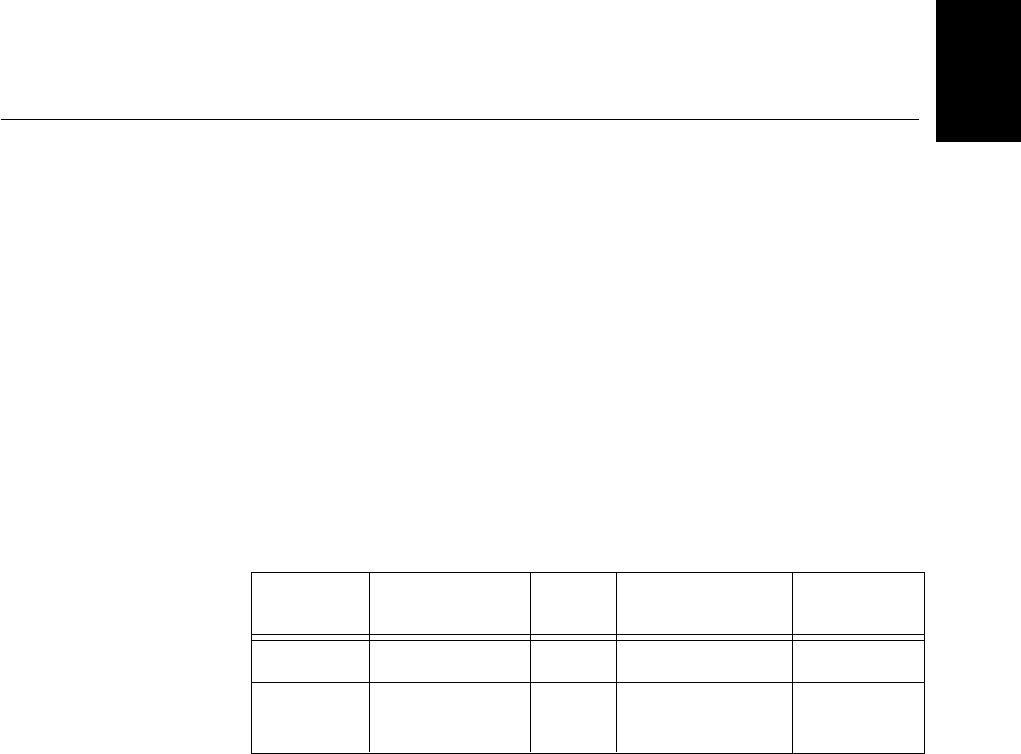
ENGLISH
23
To benefit from power management, the monitor must be used in
conjunction with a computer that implements the Video Electronics
Standards Association (VESA) Display Power Management Signaling
(DPMS) Standard.
The power management feature is invoked when the computer recognizes
that you have not used your mouse or keyboard for a user-definable period.
There are several states as described in the table below.
As an Energy Star 2000®Partner, IBM has determined that this product
meets the Energy Star 2000 guidelines for energy efficiency.
For optimal performance switch off your monitor at the end of each working
day, or whenever you expect to leave it unused for long periods during the
day.
Power management
The fluorescent lamps in the liquid crystal display contain a small amount of
mercury. Dispose of it as required by local ordinances and regulations.
Product disposal
On
Active off
State Power
Indicator
Steady green Normal
Blank
Steady amber
Screen Restoring
Operation Compliance
Press a key or
move the mouse.*ENERGY
STAR 2000
* There may be a slight delay before the picture reappears.
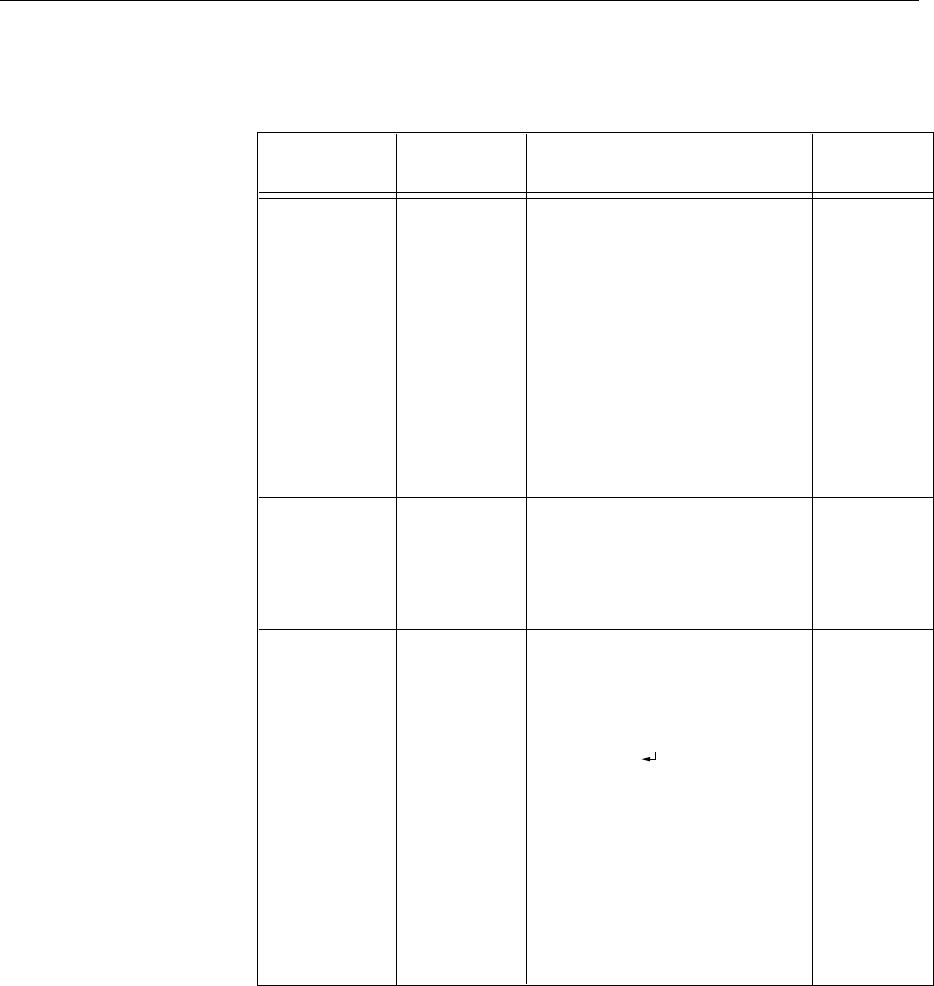
24
Troubleshooting
If you have a problem setting up or using your monitor, you may be able
to solve it yourself. Before calling your retailer or IBM, try the suggested
actions that are appropriate to your problem.
Problem
No power to
monitor.
Possible
Cause Suggested Action Reference
Brightness
and Contrast
may be too
low.
The monitor is
in the Power
Management
Standby state.
Screen is
blank and
power
indicator is off.
Screen is blank
and power
indicator is
steady green.
Screen is blank
and power
indicator is
steady amber.
"User
Controls"
section on
page 18.
"Power
Management"
section on
page 23.
"Connecting
your Monitor"
section on
page 9.
••Adjust brightness and contrast.
••Press any key on the keyboard
or move the mouse to restore
operation.
••Check the Power Management
software on your computer.
••Press the " " to switch
between analog and digital
mode. If the panel is the wrong
mode for the signal being
provided, the monitor appears
to go into sleep mode.
•• Ensure that the electrical outlet
and the monitor are both
switched on.
•• Check that the power cord
is firmly plugged into the
electrical outlet and the power
supply unit.
•• If the power cord plug has
a removable fuse, replace it.
•• Try another power cord.
•• Try another electrical outlet.
•• Check the power connection at
the back of the panel.
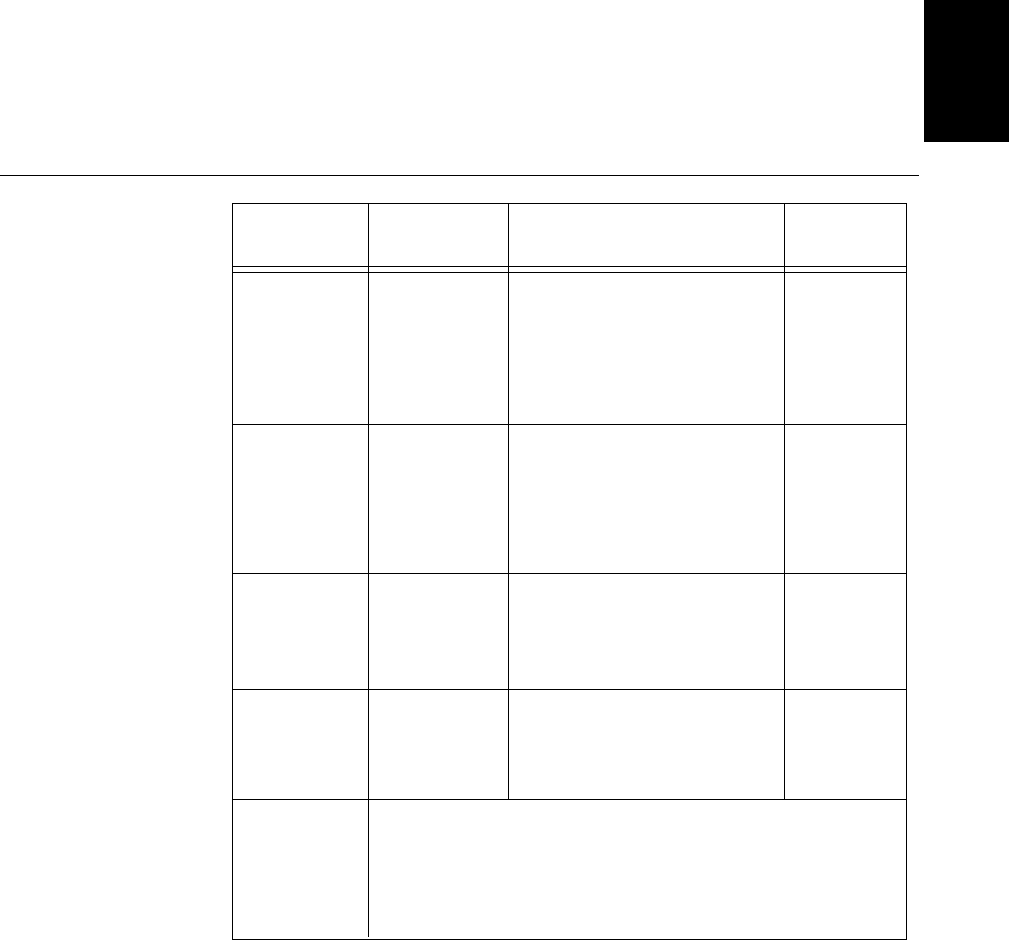
ENGLISH
25
i
For image problems, you
may want to run Image
setup again before consulting
to this section. In most cases,
Image setup can fix the
problems. See Automatic
Image setup for the computer
on page 14 for details.
Problem Possible
Cause Suggested Action Reference
There are noises
in the video
signal
The color setting
may be incorrect.
A small number of missing, discolored, or lighted dots may be
present on the screen, which is an intrinsic characteristic of the
TFT LCD technology and is not an LCD defect.
Screen is blank
and power
indicator is
flashing green
every 0.5
second
CHECK
SIGNAL
CABLE
message is
shown and
power indicator
is steady amber.
Image appears
to be smeared
Image appears
to be discolored
A few dots are
missing,
discolored, or
inappropriately
lighted.
"User
Controls"
section on
page 20.
"User
Controls"
section on
page 20.
••Select Image setup menu
in the OSD. Then select
Manual to adjust Clock / Phase
settings.
••Adjust the Color settings.
"Connecting
your monitor"
section on
page 9.
••Check that the signal cable
is firmly connected to the
computer.
•• Check that no pins are bent
in the signal cable connector.
The monitor is
not receiving a
video signal
Display mode of
the
computer
is
outside the
range of the
monitor
••Reconfigure key on the
computer to use a supported
display mode.
"Futher
Information"
section on
page 22.

26
If you are unable to correct the problem yourself, you may seek further help
as follows:
Call the IBM Service and Support.
In the U.S.A and Puerto Rico call 1-800-772-2227
In Canada (Toronto only) call 416-383-3344
In Canada (all other) call 1-800-565-3344
In other countries contact your dealer, retailer, or other IBM authorized
service representative.
Before calling, please have available as much of the following information as
possible:
1. Model and serial number from the label on your monitor.
2. Purchase receipt.
3. Description of problem.
4. Computer type and model.
5. System configuration (hardware fitted, etc.).
6. System BIOS version number.
7. Operating System and version number.
8. Display driver version number.
9. Video Adapter Type.
Help and service information
i
More help, late-breaking
news and details of the
latest accessories for these
products may be found on the
worldwide web at:
i
If possible, stay by your
computer. Your Technical
Support Representative may
wish to go through the problem
with you during the call.
http://www.pc.ibm.com/us/
accessories
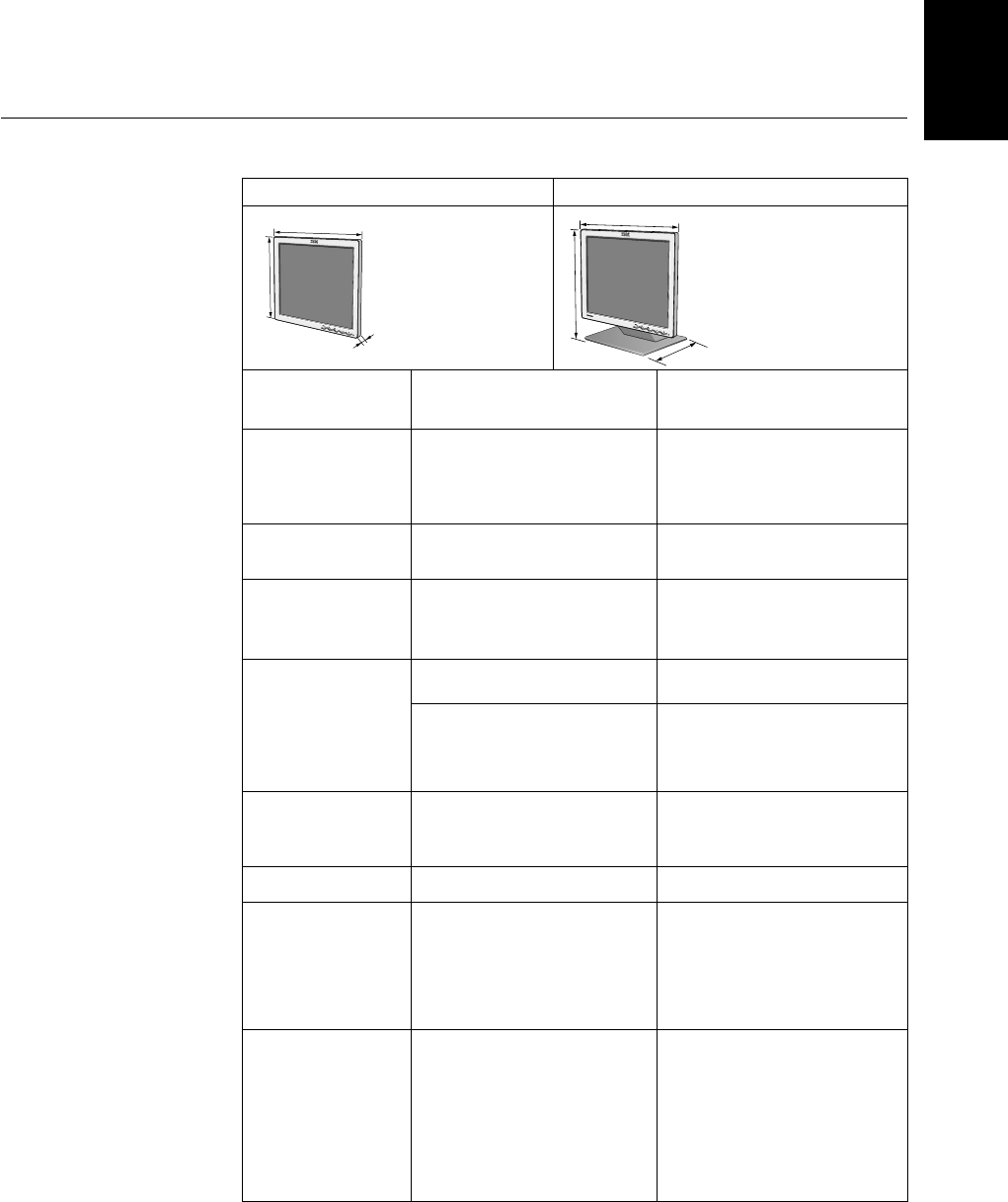
ENGLISH
27
i
Power consumption figures
are for the monitor and the
power supply combined.
Specifications
This color monitor (Type-model 6734-Axx) uses a 17.0-inch TFT LCD.
Weight 5.3 kg (11.684 lbs)
7.3 kg (16.094 lbs)
Without Stand:
With Stand:
17.0 inch (432.7 mm)
337.9 mm
270.3 mm
0.264 mm (H) x 0.264 mm (V)
100 - 240 Vac 60/50 ± 3Hz
1A
< 40 W
< 2 W
< 2 W
Analog-75 ohm 0.7V
1280 pixels (max)
1024 lines (max)
135 MHz
IBM, VESA, MAC
31-81 kHz
55-75 Hz
Analog - Separate
10 to 35° C
- 20 to 60° C
- 20 to 60° C
10 to 80%
5 to 95%
5 to 95%
Image
Power Input
Power
Consumption
Video Input
Communications
Sync Input
VESA DDC:
Type
DDC 1/2B
Supported Display
Modes
Environment
Without Stand With Stand
Viewable Image Size:
Maximum Height:
Maximum Width:
Pixel Pitch:
Supply Voltage:
Rated Current:
Normal Operation:
Active off:
Off:
Input Signal:
Horiz. Addressability:
Vert. Addressability:
Clock Frequency:
Standard modes :
Horiz. Frequency:
Vert. Frequency:
Temperature:
Operating:
Storage:
Shipping:
Humidity:
Operating:
Storage:
Shipping:
H
W
D
ThinkVision
H
D
W
Height:
341.5 mm (13.44 in.)
Width:
398.9 mm (15.70 in.)
Depth:
62.0 mm (2.44 in. )
Height:
412.9 mm (16.26 in.)
Width:
398.9 mm (15.70 in.)
Depth:
222.0 mm (8.74 in.)
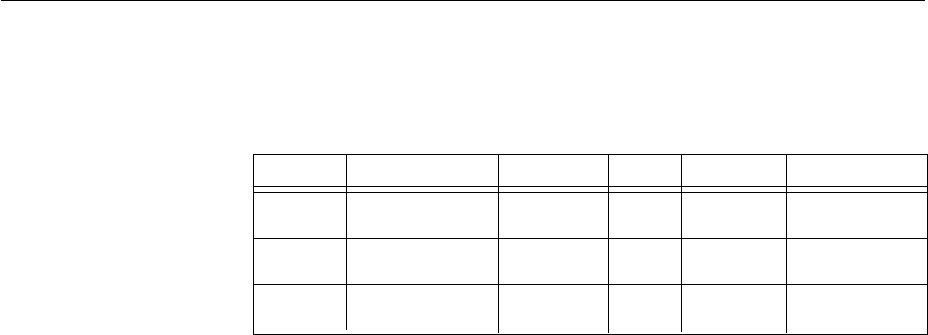
28
FRU Monitor
FRU Stand
FRU Video
Interface Cable
Hybrid
Hybrid
Analog
1.8 Meter
Black
Black
Black
6734-AB9
6734-AB9
6734-AG9
6734-AB9
6734-AG9
WW
WW
WW
Service information
The following parts are for use by IBM service, or IBM authorized dealers,
to support the customer warranty. Parts are for service use only.
Model Type 6734
Description
P/N Video
73P2737
73P2740
22P7936
Color MTM Geography

ENGLISH
29
Notices and trademarks
This section contains information on notices and trademarks.
Notices
IBM may not offer the products, services, or feature discussed in this document in all
countries. Consult your local IBM representative for information on the products and
services currently available in your area. Any reference to an IBM product, program,
or service is not intended to state or imply that only that IBM product, program, or
service may be used. Any functionally equivalent product, program, or service that
does not infringe any IBM intellectual property right may be used instead. However, it
is the user's responsibility to evaluate and verify the operation of any non-IBM
product, program, or service.
IBM may have patents or pending patent applications covering subject matter
described in this document. The furnishing of this document does not give you any
license to these patents. You can send license inquiries, in writing, to:
IBM Director of Licensing
IBM Corporation
North Castle Drive
Armonk, NY 10504-1785
U.S.A
The following paragraph does not apply to the United Kingdom or any country
where such provisions are inconsistent with local law: INTERNATIONAL
BUSINESS MACHINES CORPORATION PROVIDES THIS PUBLICATION “AS IS”
WITHOUT WARRANTY OF ANY KIND, EITHER EXPRESS OR IMPLIED,
INCLUDING, BUT NOT LIMITED TO, THE IMPLIED WARRANTIES OF NON-
INFRINGEMENT, MERCHANTABILITY OR FITNESS FOR A PARTICULAR
PURPOSE. Some states do not allow disclaimer of express or implied warranties in
certain transactions, therefore, this statement may not apply to you.
This information could include technical inaccuracies or typographical errors.
Changes are periodically made to the information herein; these changes will be
incorporated in new editions of the publication. IBM may maker improvements and/or
changes in the product(s) and/or the program(s) described in this publication at any
time without notice.
IBM may use or distribute any for the information you supply in any way it believes
appropriate without incurring any obligation to you.
Any references in this publication to non-IBM Web sites are provided for
convenience only and do not in any manner serve as an endorsement of those Web
sites. The materials at those Web sites are not part of the materials for this IBM
product, and use of those Web sites is at your own risk.

30
Trademarks
The following terms, used in this publication, are trademarks or service marks of the
IBM Corporation in the United States, other countries, or both;
IBM
IBM logo
ThinkPad
ENERGY STAR and the ENERGY STAR logo are U.S Govt. registered trademarks.
Microsoft, Windows, and Windows NT are trademarks of Microsoft Corporation in the
United States, other countries, of both.
Other company, product, and service names may be trademarks or service marks of
other.
© Copyright International Business Machines Corporation 2004. All rights reserved.